Entrepreneurship & Small Business Management Report - UK Economy
VerifiedAdded on 2024/06/04
|31
|5629
|113
Report
AI Summary
This report provides an overview of entrepreneurship and small business management, focusing on the UK economy. It defines entrepreneurship, enterprises, and different venture types like smaller profit ventures, high growth ventures, social entrepreneurship, lifestyle ventures, and serial entrepreneurs. The report explores the similarities and differences between these ventures, using Better Placed Ltd as a case study. It assesses the impact of micro and small businesses on the UK's economy, highlighting the importance of SMEs and providing relevant data and statistics. Furthermore, the report delves into the entrepreneurial mindset, discussing the characteristics, traits, and skills of successful entrepreneurs, and examines the influence of personal background and experience on entrepreneurship. The analysis covers both the public and corporate sectors, emphasizing the role of government support and innovative ideas in business growth. Desklib offers more resources for students.

ENTREPRENEURSHIP AND
SMALL BUSINESS
MANAGEMENT
admin
SMALL BUSINESS
MANAGEMENT
admin
Secure Best Marks with AI Grader
Need help grading? Try our AI Grader for instant feedback on your assignments.
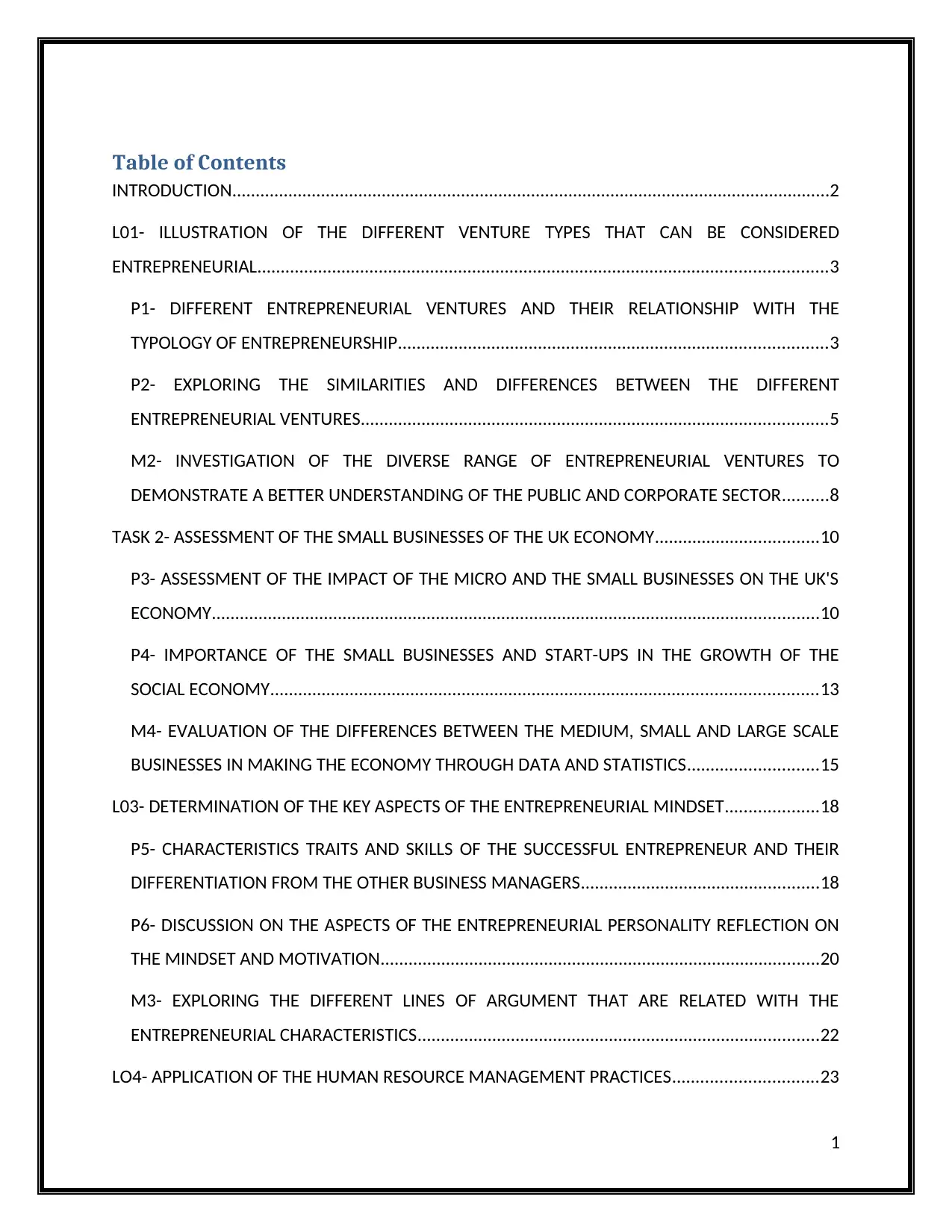
Table of Contents
INTRODUCTION................................................................................................................................2
L01- ILLUSTRATION OF THE DIFFERENT VENTURE TYPES THAT CAN BE CONSIDERED
ENTREPRENEURIAL..........................................................................................................................3
P1- DIFFERENT ENTREPRENEURIAL VENTURES AND THEIR RELATIONSHIP WITH THE
TYPOLOGY OF ENTREPRENEURSHIP............................................................................................3
P2- EXPLORING THE SIMILARITIES AND DIFFERENCES BETWEEN THE DIFFERENT
ENTREPRENEURIAL VENTURES....................................................................................................5
M2- INVESTIGATION OF THE DIVERSE RANGE OF ENTREPRENEURIAL VENTURES TO
DEMONSTRATE A BETTER UNDERSTANDING OF THE PUBLIC AND CORPORATE SECTOR..........8
TASK 2- ASSESSMENT OF THE SMALL BUSINESSES OF THE UK ECONOMY...................................10
P3- ASSESSMENT OF THE IMPACT OF THE MICRO AND THE SMALL BUSINESSES ON THE UK'S
ECONOMY..................................................................................................................................10
P4- IMPORTANCE OF THE SMALL BUSINESSES AND START-UPS IN THE GROWTH OF THE
SOCIAL ECONOMY.....................................................................................................................13
M4- EVALUATION OF THE DIFFERENCES BETWEEN THE MEDIUM, SMALL AND LARGE SCALE
BUSINESSES IN MAKING THE ECONOMY THROUGH DATA AND STATISTICS............................15
L03- DETERMINATION OF THE KEY ASPECTS OF THE ENTREPRENEURIAL MINDSET....................18
P5- CHARACTERISTICS TRAITS AND SKILLS OF THE SUCCESSFUL ENTREPRENEUR AND THEIR
DIFFERENTIATION FROM THE OTHER BUSINESS MANAGERS...................................................18
P6- DISCUSSION ON THE ASPECTS OF THE ENTREPRENEURIAL PERSONALITY REFLECTION ON
THE MINDSET AND MOTIVATION..............................................................................................20
M3- EXPLORING THE DIFFERENT LINES OF ARGUMENT THAT ARE RELATED WITH THE
ENTREPRENEURIAL CHARACTERISTICS......................................................................................22
LO4- APPLICATION OF THE HUMAN RESOURCE MANAGEMENT PRACTICES...............................23
1
INTRODUCTION................................................................................................................................2
L01- ILLUSTRATION OF THE DIFFERENT VENTURE TYPES THAT CAN BE CONSIDERED
ENTREPRENEURIAL..........................................................................................................................3
P1- DIFFERENT ENTREPRENEURIAL VENTURES AND THEIR RELATIONSHIP WITH THE
TYPOLOGY OF ENTREPRENEURSHIP............................................................................................3
P2- EXPLORING THE SIMILARITIES AND DIFFERENCES BETWEEN THE DIFFERENT
ENTREPRENEURIAL VENTURES....................................................................................................5
M2- INVESTIGATION OF THE DIVERSE RANGE OF ENTREPRENEURIAL VENTURES TO
DEMONSTRATE A BETTER UNDERSTANDING OF THE PUBLIC AND CORPORATE SECTOR..........8
TASK 2- ASSESSMENT OF THE SMALL BUSINESSES OF THE UK ECONOMY...................................10
P3- ASSESSMENT OF THE IMPACT OF THE MICRO AND THE SMALL BUSINESSES ON THE UK'S
ECONOMY..................................................................................................................................10
P4- IMPORTANCE OF THE SMALL BUSINESSES AND START-UPS IN THE GROWTH OF THE
SOCIAL ECONOMY.....................................................................................................................13
M4- EVALUATION OF THE DIFFERENCES BETWEEN THE MEDIUM, SMALL AND LARGE SCALE
BUSINESSES IN MAKING THE ECONOMY THROUGH DATA AND STATISTICS............................15
L03- DETERMINATION OF THE KEY ASPECTS OF THE ENTREPRENEURIAL MINDSET....................18
P5- CHARACTERISTICS TRAITS AND SKILLS OF THE SUCCESSFUL ENTREPRENEUR AND THEIR
DIFFERENTIATION FROM THE OTHER BUSINESS MANAGERS...................................................18
P6- DISCUSSION ON THE ASPECTS OF THE ENTREPRENEURIAL PERSONALITY REFLECTION ON
THE MINDSET AND MOTIVATION..............................................................................................20
M3- EXPLORING THE DIFFERENT LINES OF ARGUMENT THAT ARE RELATED WITH THE
ENTREPRENEURIAL CHARACTERISTICS......................................................................................22
LO4- APPLICATION OF THE HUMAN RESOURCE MANAGEMENT PRACTICES...............................23
1

P7- EXAMINATION OF THE RELEVANT EXAMPLES OF HOW THE BACKGROUND AND
EXPERIENCE FOSTERS OR HIDERS ENTREPRENEURSHIP...........................................................23
M4- ANALYSIS OF THE LINK BETWEEN THE ENTREPRENEURIAL CHARACTERISTICS AND
INFLUENCE OF THE PERSONAL BACKGROUND AND EXPERIENCE OF SUCCESSFUL
ENTREPRENEURS.......................................................................................................................25
CONCLUSION.................................................................................................................................26
REFERENCES...................................................................................................................................27
2
EXPERIENCE FOSTERS OR HIDERS ENTREPRENEURSHIP...........................................................23
M4- ANALYSIS OF THE LINK BETWEEN THE ENTREPRENEURIAL CHARACTERISTICS AND
INFLUENCE OF THE PERSONAL BACKGROUND AND EXPERIENCE OF SUCCESSFUL
ENTREPRENEURS.......................................................................................................................25
CONCLUSION.................................................................................................................................26
REFERENCES...................................................................................................................................27
2
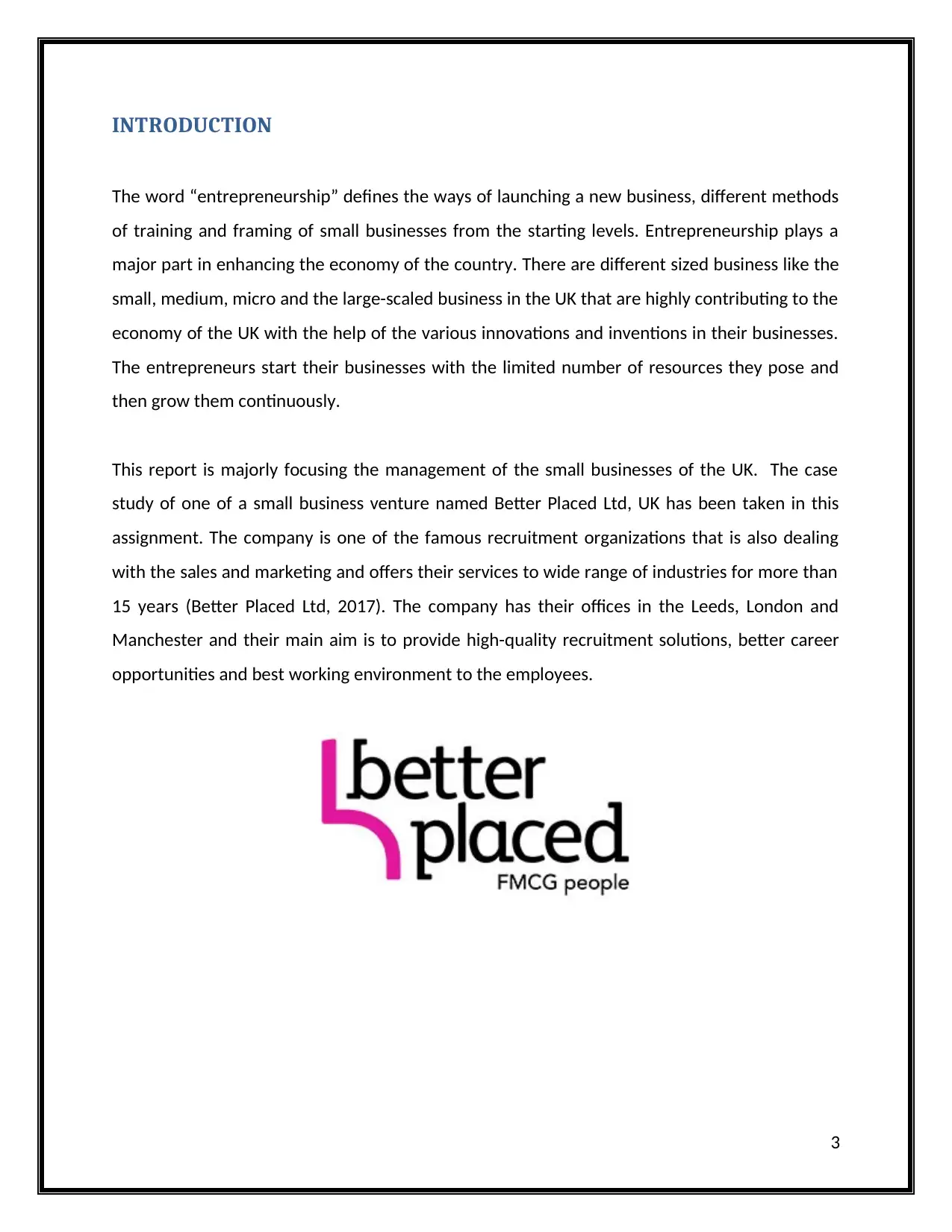
INTRODUCTION
The word “entrepreneurship” defines the ways of launching a new business, different methods
of training and framing of small businesses from the starting levels. Entrepreneurship plays a
major part in enhancing the economy of the country. There are different sized business like the
small, medium, micro and the large-scaled business in the UK that are highly contributing to the
economy of the UK with the help of the various innovations and inventions in their businesses.
The entrepreneurs start their businesses with the limited number of resources they pose and
then grow them continuously.
This report is majorly focusing the management of the small businesses of the UK. The case
study of one of a small business venture named Better Placed Ltd, UK has been taken in this
assignment. The company is one of the famous recruitment organizations that is also dealing
with the sales and marketing and offers their services to wide range of industries for more than
15 years (Better Placed Ltd, 2017). The company has their offices in the Leeds, London and
Manchester and their main aim is to provide high-quality recruitment solutions, better career
opportunities and best working environment to the employees.
3
The word “entrepreneurship” defines the ways of launching a new business, different methods
of training and framing of small businesses from the starting levels. Entrepreneurship plays a
major part in enhancing the economy of the country. There are different sized business like the
small, medium, micro and the large-scaled business in the UK that are highly contributing to the
economy of the UK with the help of the various innovations and inventions in their businesses.
The entrepreneurs start their businesses with the limited number of resources they pose and
then grow them continuously.
This report is majorly focusing the management of the small businesses of the UK. The case
study of one of a small business venture named Better Placed Ltd, UK has been taken in this
assignment. The company is one of the famous recruitment organizations that is also dealing
with the sales and marketing and offers their services to wide range of industries for more than
15 years (Better Placed Ltd, 2017). The company has their offices in the Leeds, London and
Manchester and their main aim is to provide high-quality recruitment solutions, better career
opportunities and best working environment to the employees.
3
Secure Best Marks with AI Grader
Need help grading? Try our AI Grader for instant feedback on your assignments.
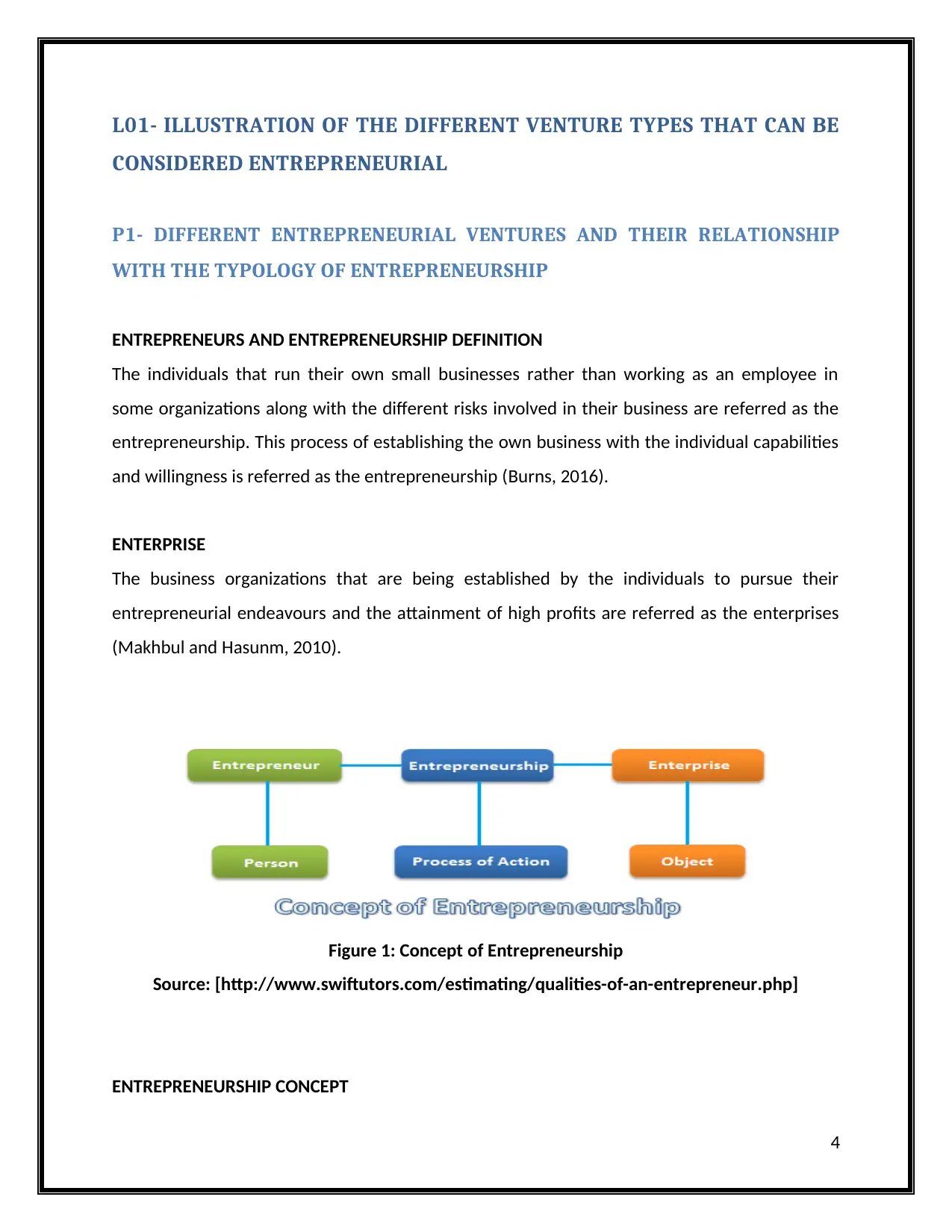
L01- ILLUSTRATION OF THE DIFFERENT VENTURE TYPES THAT CAN BE
CONSIDERED ENTREPRENEURIAL
P1- DIFFERENT ENTREPRENEURIAL VENTURES AND THEIR RELATIONSHIP
WITH THE TYPOLOGY OF ENTREPRENEURSHIP
ENTREPRENEURS AND ENTREPRENEURSHIP DEFINITION
The individuals that run their own small businesses rather than working as an employee in
some organizations along with the different risks involved in their business are referred as the
entrepreneurship. This process of establishing the own business with the individual capabilities
and willingness is referred as the entrepreneurship (Burns, 2016).
ENTERPRISE
The business organizations that are being established by the individuals to pursue their
entrepreneurial endeavours and the attainment of high profits are referred as the enterprises
(Makhbul and Hasunm, 2010).
Figure 1: Concept of Entrepreneurship
Source: [http://www.swiftutors.com/estimating/qualities-of-an-entrepreneur.php]
ENTREPRENEURSHIP CONCEPT
4
CONSIDERED ENTREPRENEURIAL
P1- DIFFERENT ENTREPRENEURIAL VENTURES AND THEIR RELATIONSHIP
WITH THE TYPOLOGY OF ENTREPRENEURSHIP
ENTREPRENEURS AND ENTREPRENEURSHIP DEFINITION
The individuals that run their own small businesses rather than working as an employee in
some organizations along with the different risks involved in their business are referred as the
entrepreneurship. This process of establishing the own business with the individual capabilities
and willingness is referred as the entrepreneurship (Burns, 2016).
ENTERPRISE
The business organizations that are being established by the individuals to pursue their
entrepreneurial endeavours and the attainment of high profits are referred as the enterprises
(Makhbul and Hasunm, 2010).
Figure 1: Concept of Entrepreneurship
Source: [http://www.swiftutors.com/estimating/qualities-of-an-entrepreneur.php]
ENTREPRENEURSHIP CONCEPT
4
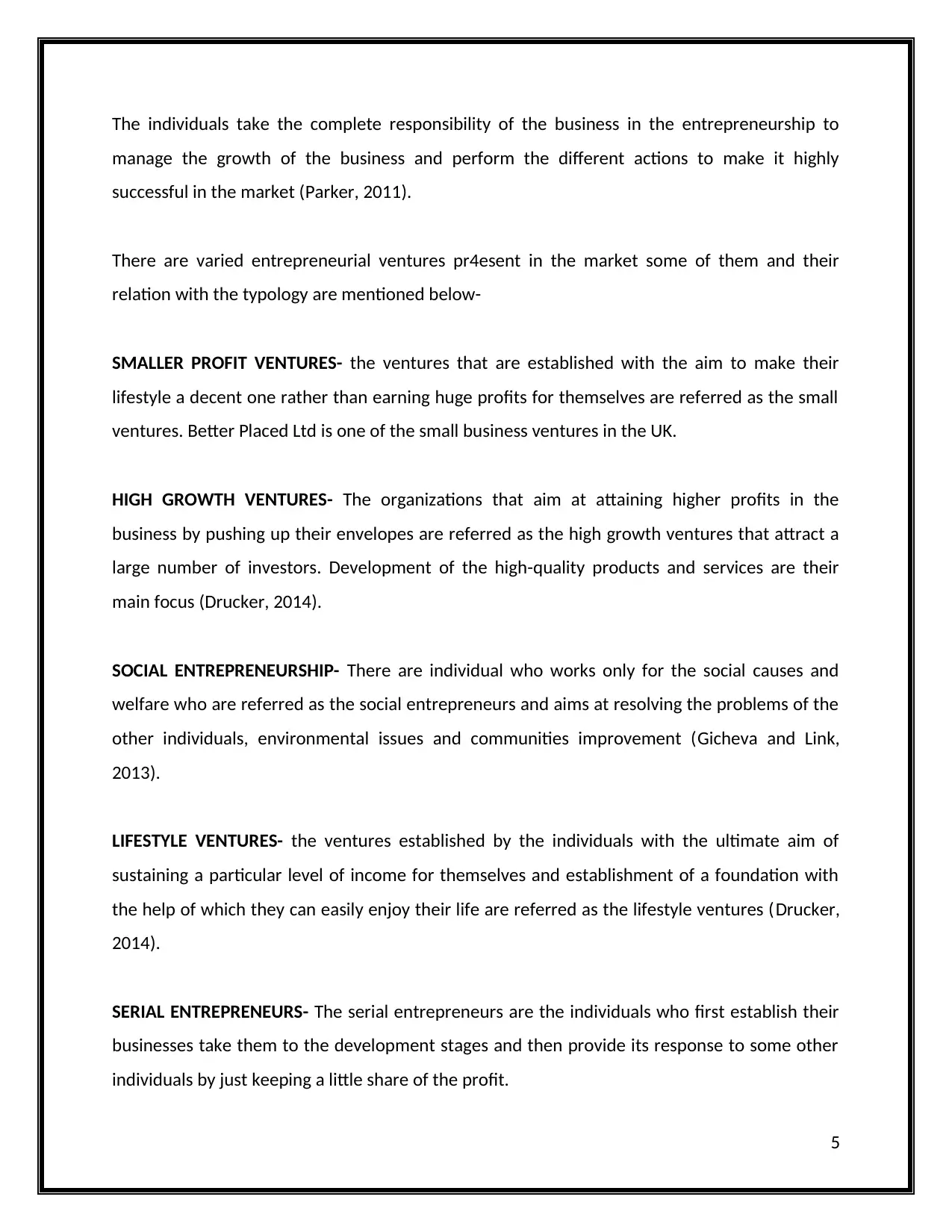
The individuals take the complete responsibility of the business in the entrepreneurship to
manage the growth of the business and perform the different actions to make it highly
successful in the market (Parker, 2011).
There are varied entrepreneurial ventures pr4esent in the market some of them and their
relation with the typology are mentioned below-
SMALLER PROFIT VENTURES- the ventures that are established with the aim to make their
lifestyle a decent one rather than earning huge profits for themselves are referred as the small
ventures. Better Placed Ltd is one of the small business ventures in the UK.
HIGH GROWTH VENTURES- The organizations that aim at attaining higher profits in the
business by pushing up their envelopes are referred as the high growth ventures that attract a
large number of investors. Development of the high-quality products and services are their
main focus (Drucker, 2014).
SOCIAL ENTREPRENEURSHIP- There are individual who works only for the social causes and
welfare who are referred as the social entrepreneurs and aims at resolving the problems of the
other individuals, environmental issues and communities improvement (Gicheva and Link,
2013).
LIFESTYLE VENTURES- the ventures established by the individuals with the ultimate aim of
sustaining a particular level of income for themselves and establishment of a foundation with
the help of which they can easily enjoy their life are referred as the lifestyle ventures (Drucker,
2014).
SERIAL ENTREPRENEURS- The serial entrepreneurs are the individuals who first establish their
businesses take them to the development stages and then provide its response to some other
individuals by just keeping a little share of the profit.
5
manage the growth of the business and perform the different actions to make it highly
successful in the market (Parker, 2011).
There are varied entrepreneurial ventures pr4esent in the market some of them and their
relation with the typology are mentioned below-
SMALLER PROFIT VENTURES- the ventures that are established with the aim to make their
lifestyle a decent one rather than earning huge profits for themselves are referred as the small
ventures. Better Placed Ltd is one of the small business ventures in the UK.
HIGH GROWTH VENTURES- The organizations that aim at attaining higher profits in the
business by pushing up their envelopes are referred as the high growth ventures that attract a
large number of investors. Development of the high-quality products and services are their
main focus (Drucker, 2014).
SOCIAL ENTREPRENEURSHIP- There are individual who works only for the social causes and
welfare who are referred as the social entrepreneurs and aims at resolving the problems of the
other individuals, environmental issues and communities improvement (Gicheva and Link,
2013).
LIFESTYLE VENTURES- the ventures established by the individuals with the ultimate aim of
sustaining a particular level of income for themselves and establishment of a foundation with
the help of which they can easily enjoy their life are referred as the lifestyle ventures (Drucker,
2014).
SERIAL ENTREPRENEURS- The serial entrepreneurs are the individuals who first establish their
businesses take them to the development stages and then provide its response to some other
individuals by just keeping a little share of the profit.
5
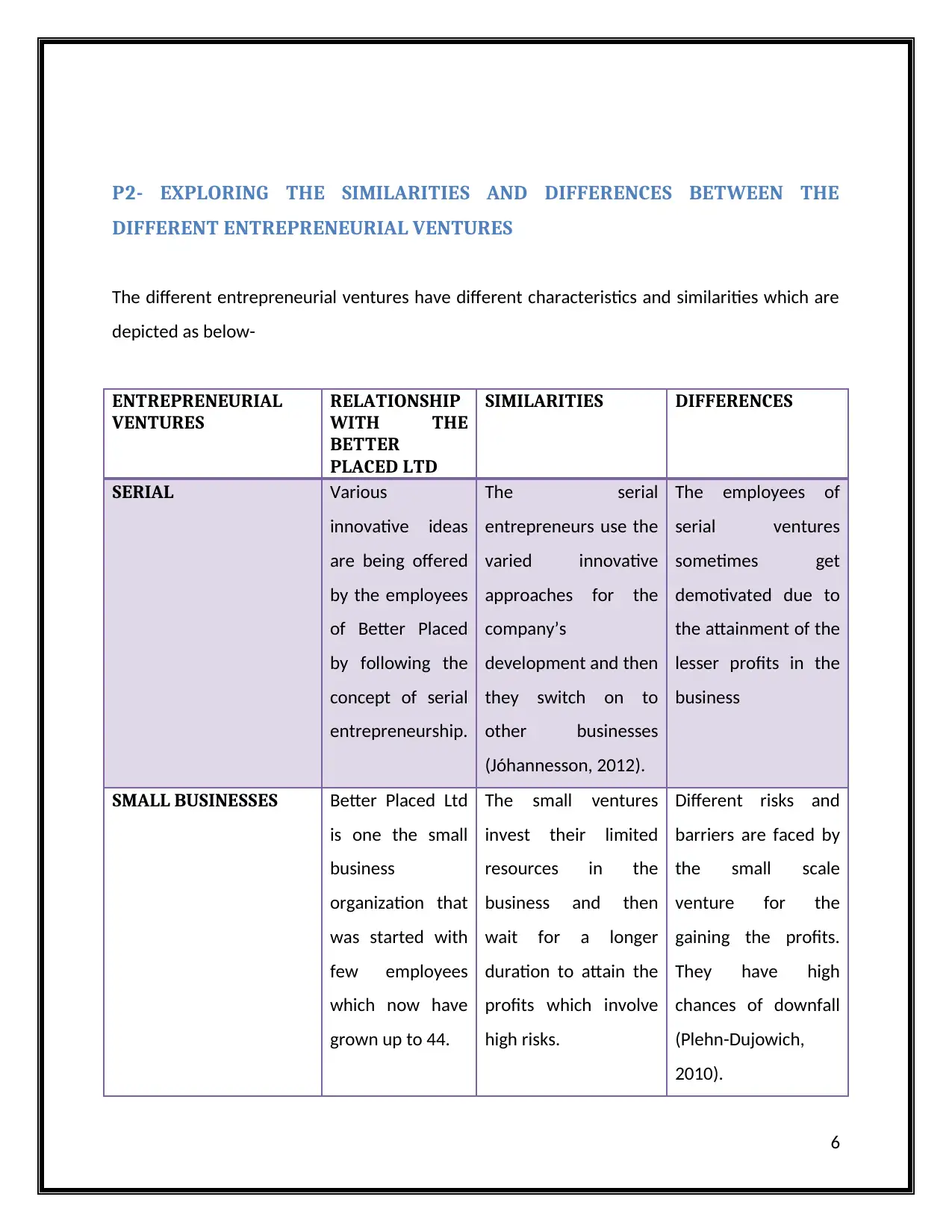
P2- EXPLORING THE SIMILARITIES AND DIFFERENCES BETWEEN THE
DIFFERENT ENTREPRENEURIAL VENTURES
The different entrepreneurial ventures have different characteristics and similarities which are
depicted as below-
ENTREPRENEURIAL
VENTURES
RELATIONSHIP
WITH THE
BETTER
PLACED LTD
SIMILARITIES DIFFERENCES
SERIAL Various
innovative ideas
are being offered
by the employees
of Better Placed
by following the
concept of serial
entrepreneurship.
The serial
entrepreneurs use the
varied innovative
approaches for the
company’s
development and then
they switch on to
other businesses
(Jóhannesson, 2012).
The employees of
serial ventures
sometimes get
demotivated due to
the attainment of the
lesser profits in the
business
SMALL BUSINESSES Better Placed Ltd
is one the small
business
organization that
was started with
few employees
which now have
grown up to 44.
The small ventures
invest their limited
resources in the
business and then
wait for a longer
duration to attain the
profits which involve
high risks.
Different risks and
barriers are faced by
the small scale
venture for the
gaining the profits.
They have high
chances of downfall
(Plehn-Dujowich,
2010).
6
DIFFERENT ENTREPRENEURIAL VENTURES
The different entrepreneurial ventures have different characteristics and similarities which are
depicted as below-
ENTREPRENEURIAL
VENTURES
RELATIONSHIP
WITH THE
BETTER
PLACED LTD
SIMILARITIES DIFFERENCES
SERIAL Various
innovative ideas
are being offered
by the employees
of Better Placed
by following the
concept of serial
entrepreneurship.
The serial
entrepreneurs use the
varied innovative
approaches for the
company’s
development and then
they switch on to
other businesses
(Jóhannesson, 2012).
The employees of
serial ventures
sometimes get
demotivated due to
the attainment of the
lesser profits in the
business
SMALL BUSINESSES Better Placed Ltd
is one the small
business
organization that
was started with
few employees
which now have
grown up to 44.
The small ventures
invest their limited
resources in the
business and then
wait for a longer
duration to attain the
profits which involve
high risks.
Different risks and
barriers are faced by
the small scale
venture for the
gaining the profits.
They have high
chances of downfall
(Plehn-Dujowich,
2010).
6
Paraphrase This Document
Need a fresh take? Get an instant paraphrase of this document with our AI Paraphraser
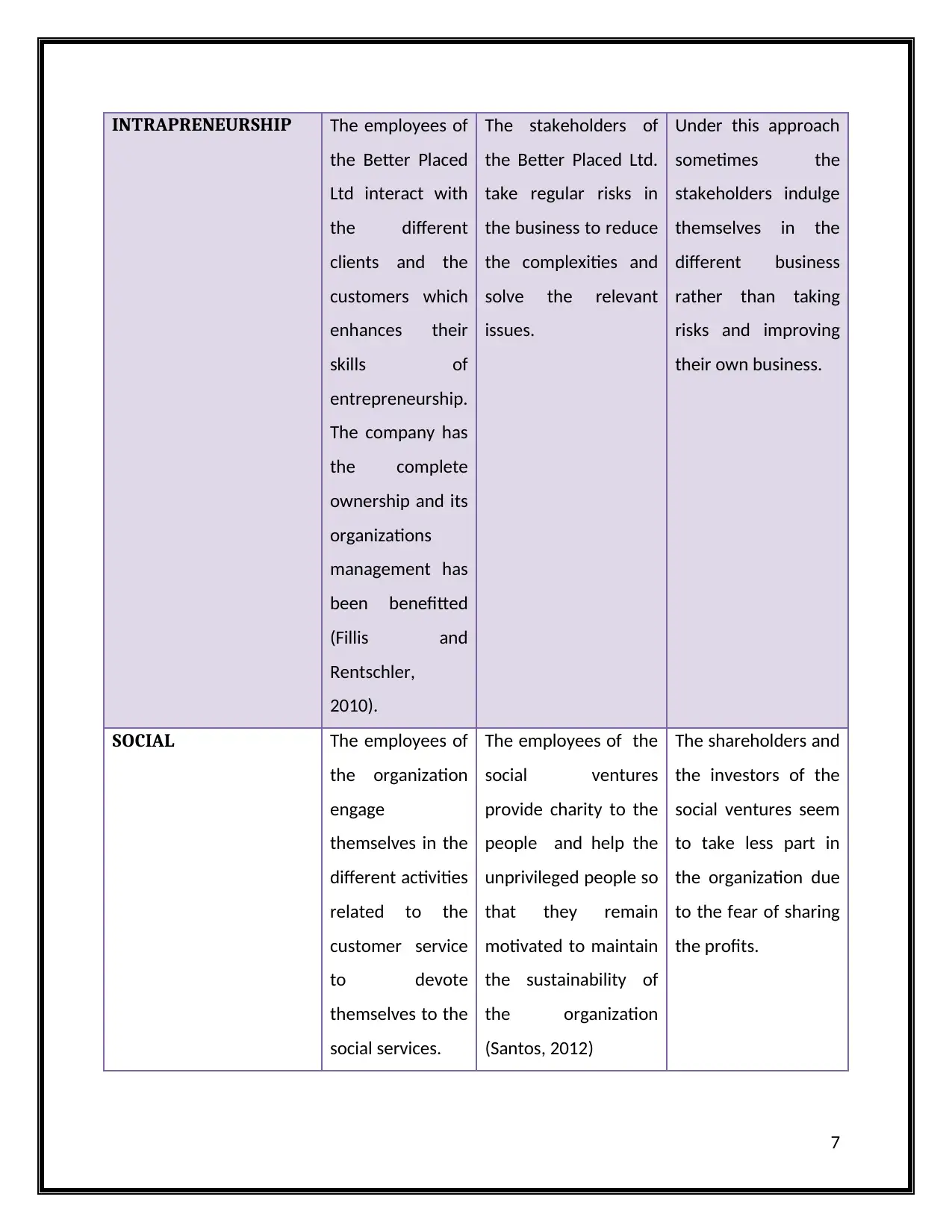
INTRAPRENEURSHIP The employees of
the Better Placed
Ltd interact with
the different
clients and the
customers which
enhances their
skills of
entrepreneurship.
The company has
the complete
ownership and its
organizations
management has
been benefitted
(Fillis and
Rentschler,
2010).
The stakeholders of
the Better Placed Ltd.
take regular risks in
the business to reduce
the complexities and
solve the relevant
issues.
Under this approach
sometimes the
stakeholders indulge
themselves in the
different business
rather than taking
risks and improving
their own business.
SOCIAL The employees of
the organization
engage
themselves in the
different activities
related to the
customer service
to devote
themselves to the
social services.
The employees of the
social ventures
provide charity to the
people and help the
unprivileged people so
that they remain
motivated to maintain
the sustainability of
the organization
(Santos, 2012)
The shareholders and
the investors of the
social ventures seem
to take less part in
the organization due
to the fear of sharing
the profits.
7
the Better Placed
Ltd interact with
the different
clients and the
customers which
enhances their
skills of
entrepreneurship.
The company has
the complete
ownership and its
organizations
management has
been benefitted
(Fillis and
Rentschler,
2010).
The stakeholders of
the Better Placed Ltd.
take regular risks in
the business to reduce
the complexities and
solve the relevant
issues.
Under this approach
sometimes the
stakeholders indulge
themselves in the
different business
rather than taking
risks and improving
their own business.
SOCIAL The employees of
the organization
engage
themselves in the
different activities
related to the
customer service
to devote
themselves to the
social services.
The employees of the
social ventures
provide charity to the
people and help the
unprivileged people so
that they remain
motivated to maintain
the sustainability of
the organization
(Santos, 2012)
The shareholders and
the investors of the
social ventures seem
to take less part in
the organization due
to the fear of sharing
the profits.
7
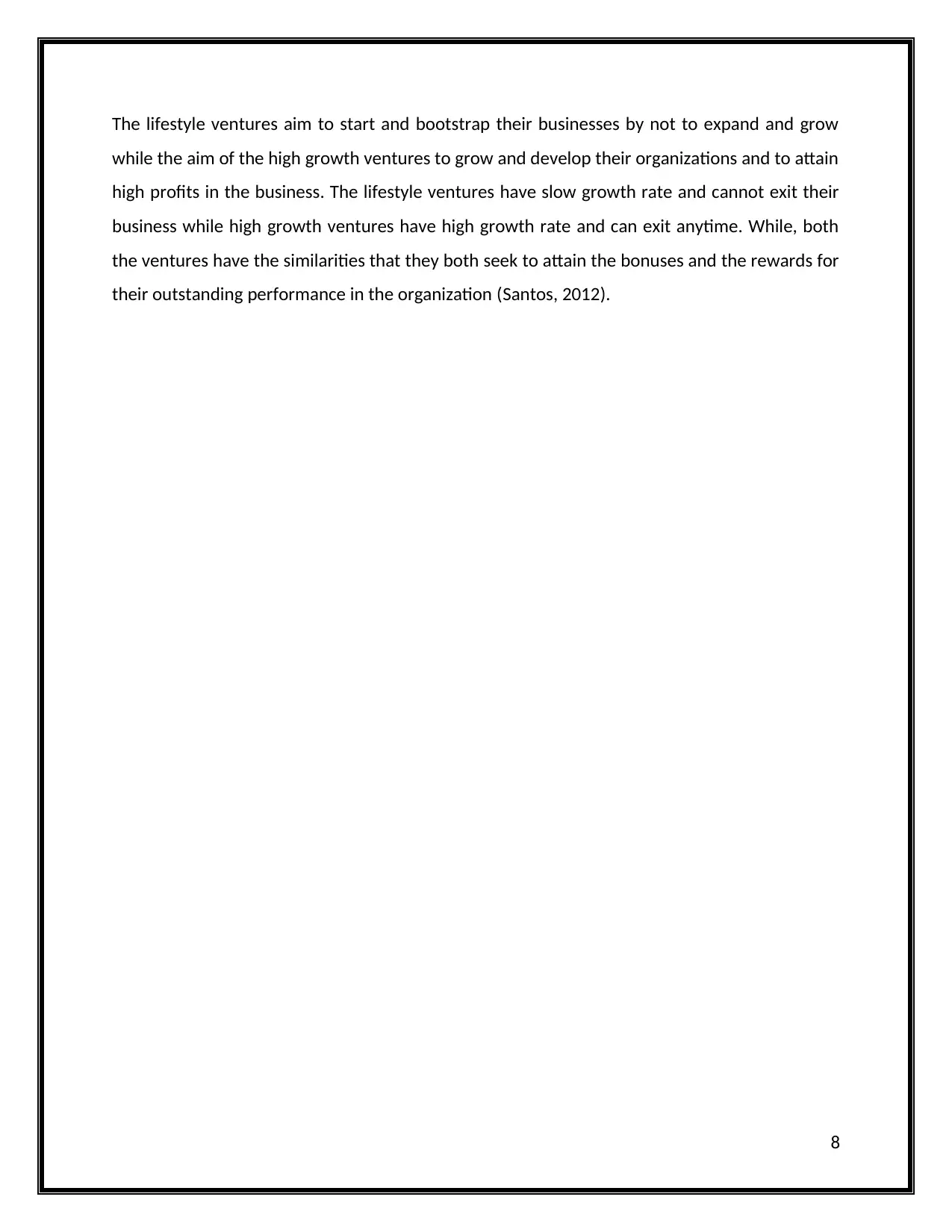
The lifestyle ventures aim to start and bootstrap their businesses by not to expand and grow
while the aim of the high growth ventures to grow and develop their organizations and to attain
high profits in the business. The lifestyle ventures have slow growth rate and cannot exit their
business while high growth ventures have high growth rate and can exit anytime. While, both
the ventures have the similarities that they both seek to attain the bonuses and the rewards for
their outstanding performance in the organization (Santos, 2012).
8
while the aim of the high growth ventures to grow and develop their organizations and to attain
high profits in the business. The lifestyle ventures have slow growth rate and cannot exit their
business while high growth ventures have high growth rate and can exit anytime. While, both
the ventures have the similarities that they both seek to attain the bonuses and the rewards for
their outstanding performance in the organization (Santos, 2012).
8
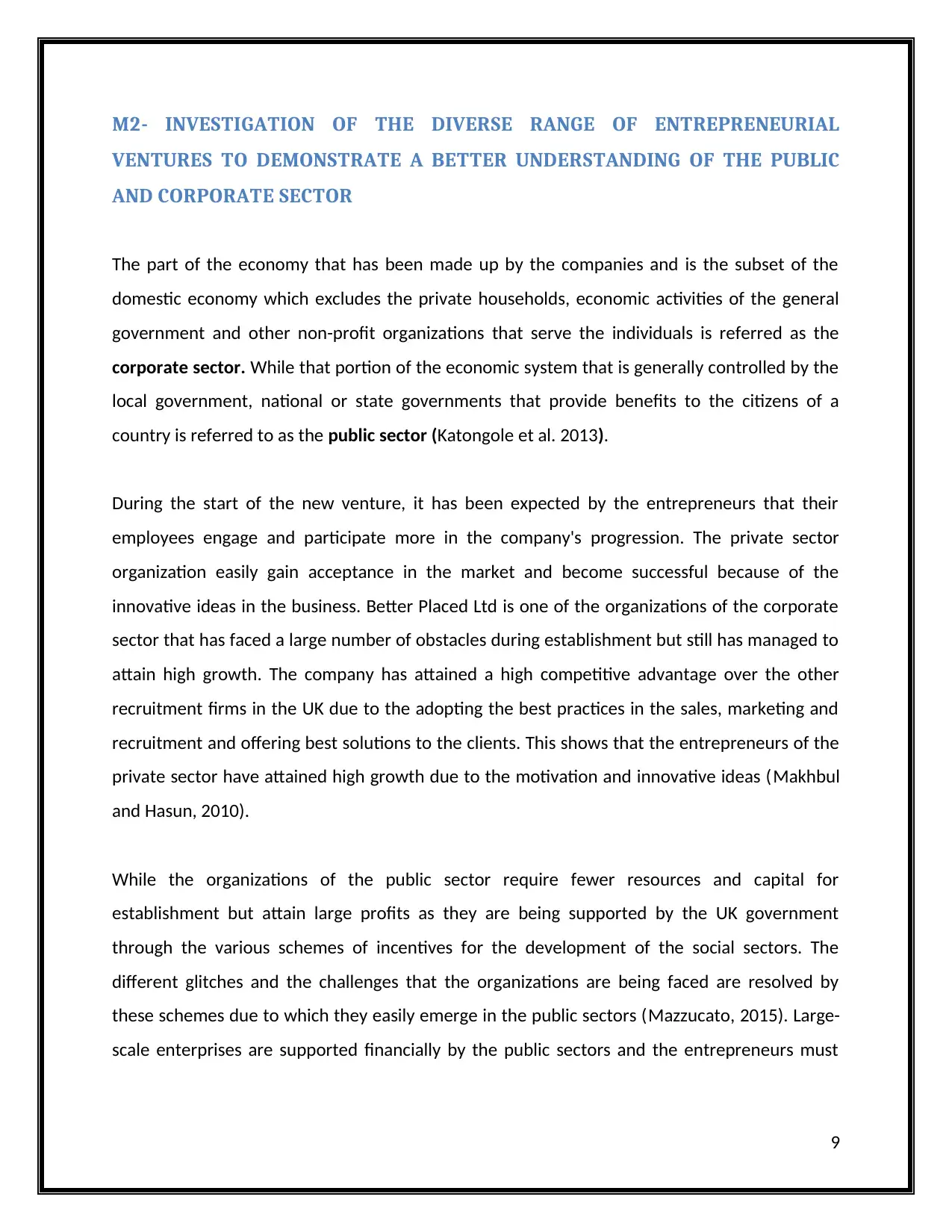
M2- INVESTIGATION OF THE DIVERSE RANGE OF ENTREPRENEURIAL
VENTURES TO DEMONSTRATE A BETTER UNDERSTANDING OF THE PUBLIC
AND CORPORATE SECTOR
The part of the economy that has been made up by the companies and is the subset of the
domestic economy which excludes the private households, economic activities of the general
government and other non-profit organizations that serve the individuals is referred as the
corporate sector. While that portion of the economic system that is generally controlled by the
local government, national or state governments that provide benefits to the citizens of a
country is referred to as the public sector (Katongole et al. 2013).
During the start of the new venture, it has been expected by the entrepreneurs that their
employees engage and participate more in the company's progression. The private sector
organization easily gain acceptance in the market and become successful because of the
innovative ideas in the business. Better Placed Ltd is one of the organizations of the corporate
sector that has faced a large number of obstacles during establishment but still has managed to
attain high growth. The company has attained a high competitive advantage over the other
recruitment firms in the UK due to the adopting the best practices in the sales, marketing and
recruitment and offering best solutions to the clients. This shows that the entrepreneurs of the
private sector have attained high growth due to the motivation and innovative ideas (Makhbul
and Hasun, 2010).
While the organizations of the public sector require fewer resources and capital for
establishment but attain large profits as they are being supported by the UK government
through the various schemes of incentives for the development of the social sectors. The
different glitches and the challenges that the organizations are being faced are resolved by
these schemes due to which they easily emerge in the public sectors (Mazzucato, 2015). Large-
scale enterprises are supported financially by the public sectors and the entrepreneurs must
9
VENTURES TO DEMONSTRATE A BETTER UNDERSTANDING OF THE PUBLIC
AND CORPORATE SECTOR
The part of the economy that has been made up by the companies and is the subset of the
domestic economy which excludes the private households, economic activities of the general
government and other non-profit organizations that serve the individuals is referred as the
corporate sector. While that portion of the economic system that is generally controlled by the
local government, national or state governments that provide benefits to the citizens of a
country is referred to as the public sector (Katongole et al. 2013).
During the start of the new venture, it has been expected by the entrepreneurs that their
employees engage and participate more in the company's progression. The private sector
organization easily gain acceptance in the market and become successful because of the
innovative ideas in the business. Better Placed Ltd is one of the organizations of the corporate
sector that has faced a large number of obstacles during establishment but still has managed to
attain high growth. The company has attained a high competitive advantage over the other
recruitment firms in the UK due to the adopting the best practices in the sales, marketing and
recruitment and offering best solutions to the clients. This shows that the entrepreneurs of the
private sector have attained high growth due to the motivation and innovative ideas (Makhbul
and Hasun, 2010).
While the organizations of the public sector require fewer resources and capital for
establishment but attain large profits as they are being supported by the UK government
through the various schemes of incentives for the development of the social sectors. The
different glitches and the challenges that the organizations are being faced are resolved by
these schemes due to which they easily emerge in the public sectors (Mazzucato, 2015). Large-
scale enterprises are supported financially by the public sectors and the entrepreneurs must
9
Secure Best Marks with AI Grader
Need help grading? Try our AI Grader for instant feedback on your assignments.

launch their businesses in the public sector as they are supported by the government which is
missing in case of corporate sectors.
10
missing in case of corporate sectors.
10
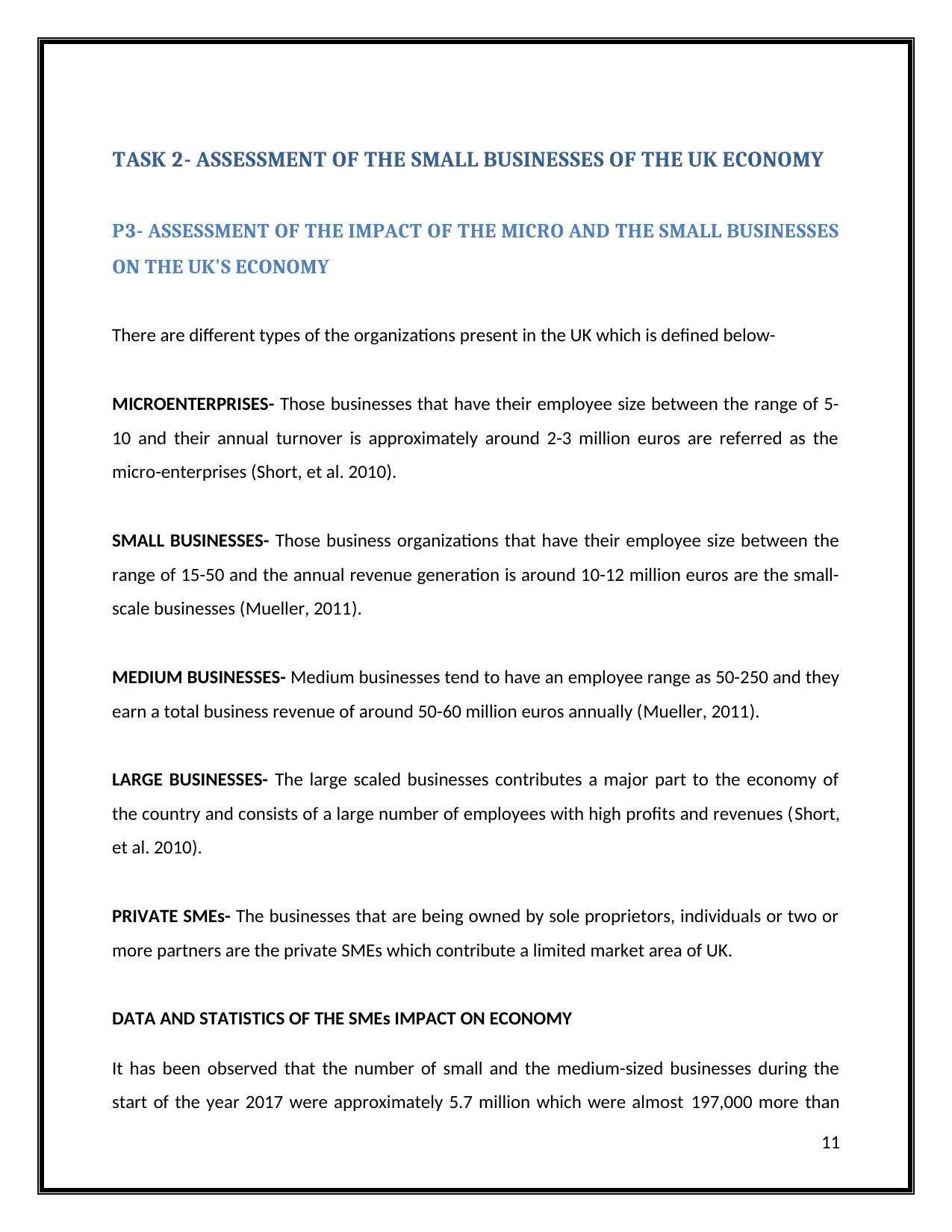
TASK 2- ASSESSMENT OF THE SMALL BUSINESSES OF THE UK ECONOMY
P3- ASSESSMENT OF THE IMPACT OF THE MICRO AND THE SMALL BUSINESSES
ON THE UK'S ECONOMY
There are different types of the organizations present in the UK which is defined below-
MICROENTERPRISES- Those businesses that have their employee size between the range of 5-
10 and their annual turnover is approximately around 2-3 million euros are referred as the
micro-enterprises (Short, et al. 2010).
SMALL BUSINESSES- Those business organizations that have their employee size between the
range of 15-50 and the annual revenue generation is around 10-12 million euros are the small-
scale businesses (Mueller, 2011).
MEDIUM BUSINESSES- Medium businesses tend to have an employee range as 50-250 and they
earn a total business revenue of around 50-60 million euros annually (Mueller, 2011).
LARGE BUSINESSES- The large scaled businesses contributes a major part to the economy of
the country and consists of a large number of employees with high profits and revenues (Short,
et al. 2010).
PRIVATE SMEs- The businesses that are being owned by sole proprietors, individuals or two or
more partners are the private SMEs which contribute a limited market area of UK.
DATA AND STATISTICS OF THE SMEs IMPACT ON ECONOMY
It has been observed that the number of small and the medium-sized businesses during the
start of the year 2017 were approximately 5.7 million which were almost 197,000 more than
11
P3- ASSESSMENT OF THE IMPACT OF THE MICRO AND THE SMALL BUSINESSES
ON THE UK'S ECONOMY
There are different types of the organizations present in the UK which is defined below-
MICROENTERPRISES- Those businesses that have their employee size between the range of 5-
10 and their annual turnover is approximately around 2-3 million euros are referred as the
micro-enterprises (Short, et al. 2010).
SMALL BUSINESSES- Those business organizations that have their employee size between the
range of 15-50 and the annual revenue generation is around 10-12 million euros are the small-
scale businesses (Mueller, 2011).
MEDIUM BUSINESSES- Medium businesses tend to have an employee range as 50-250 and they
earn a total business revenue of around 50-60 million euros annually (Mueller, 2011).
LARGE BUSINESSES- The large scaled businesses contributes a major part to the economy of
the country and consists of a large number of employees with high profits and revenues (Short,
et al. 2010).
PRIVATE SMEs- The businesses that are being owned by sole proprietors, individuals or two or
more partners are the private SMEs which contribute a limited market area of UK.
DATA AND STATISTICS OF THE SMEs IMPACT ON ECONOMY
It has been observed that the number of small and the medium-sized businesses during the
start of the year 2017 were approximately 5.7 million which were almost 197,000 more than
11
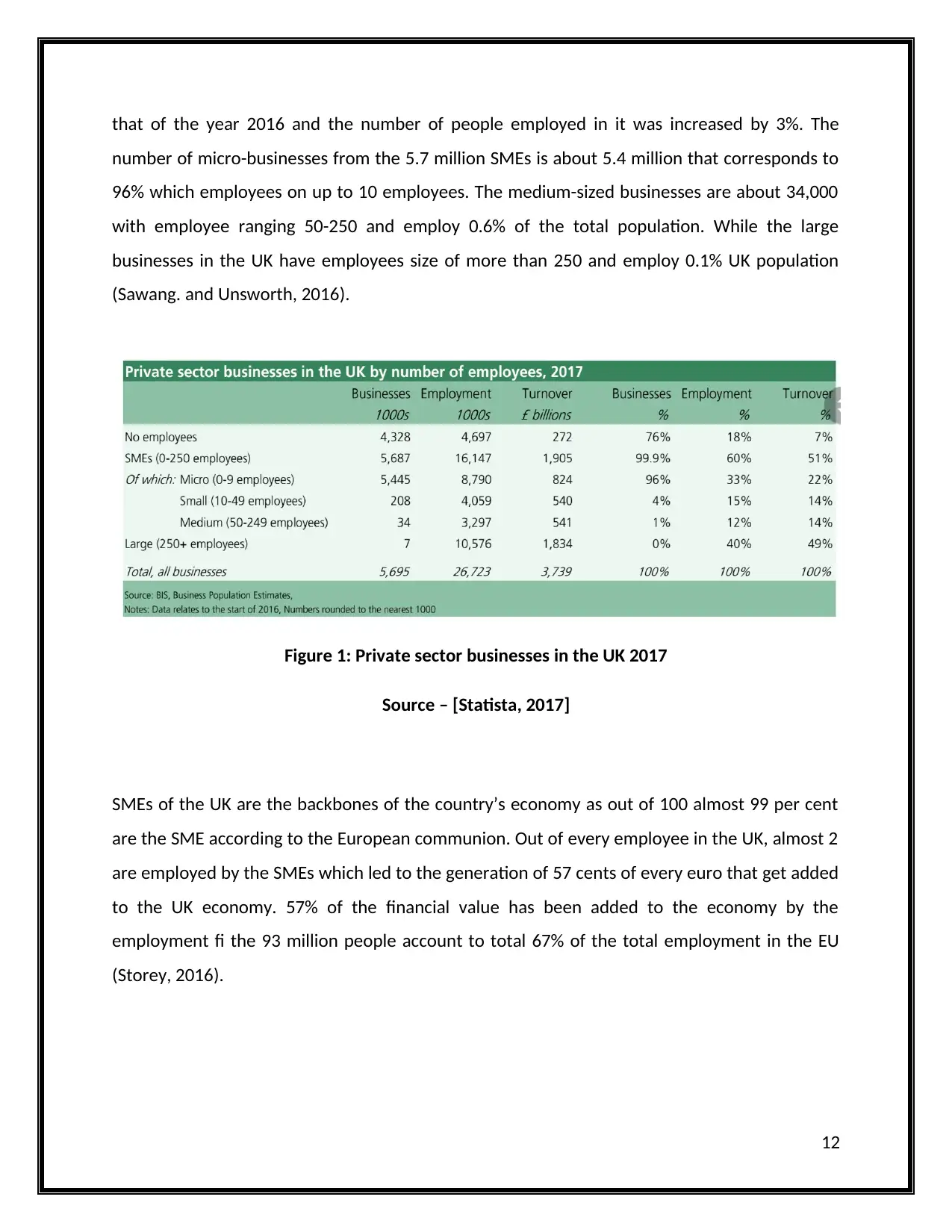
that of the year 2016 and the number of people employed in it was increased by 3%. The
number of micro-businesses from the 5.7 million SMEs is about 5.4 million that corresponds to
96% which employees on up to 10 employees. The medium-sized businesses are about 34,000
with employee ranging 50-250 and employ 0.6% of the total population. While the large
businesses in the UK have employees size of more than 250 and employ 0.1% UK population
(Sawang. and Unsworth, 2016).
Figure 1: Private sector businesses in the UK 2017
Source – [Statista, 2017]
SMEs of the UK are the backbones of the country’s economy as out of 100 almost 99 per cent
are the SME according to the European communion. Out of every employee in the UK, almost 2
are employed by the SMEs which led to the generation of 57 cents of every euro that get added
to the UK economy. 57% of the financial value has been added to the economy by the
employment fi the 93 million people account to total 67% of the total employment in the EU
(Storey, 2016).
12
number of micro-businesses from the 5.7 million SMEs is about 5.4 million that corresponds to
96% which employees on up to 10 employees. The medium-sized businesses are about 34,000
with employee ranging 50-250 and employ 0.6% of the total population. While the large
businesses in the UK have employees size of more than 250 and employ 0.1% UK population
(Sawang. and Unsworth, 2016).
Figure 1: Private sector businesses in the UK 2017
Source – [Statista, 2017]
SMEs of the UK are the backbones of the country’s economy as out of 100 almost 99 per cent
are the SME according to the European communion. Out of every employee in the UK, almost 2
are employed by the SMEs which led to the generation of 57 cents of every euro that get added
to the UK economy. 57% of the financial value has been added to the economy by the
employment fi the 93 million people account to total 67% of the total employment in the EU
(Storey, 2016).
12
Paraphrase This Document
Need a fresh take? Get an instant paraphrase of this document with our AI Paraphraser
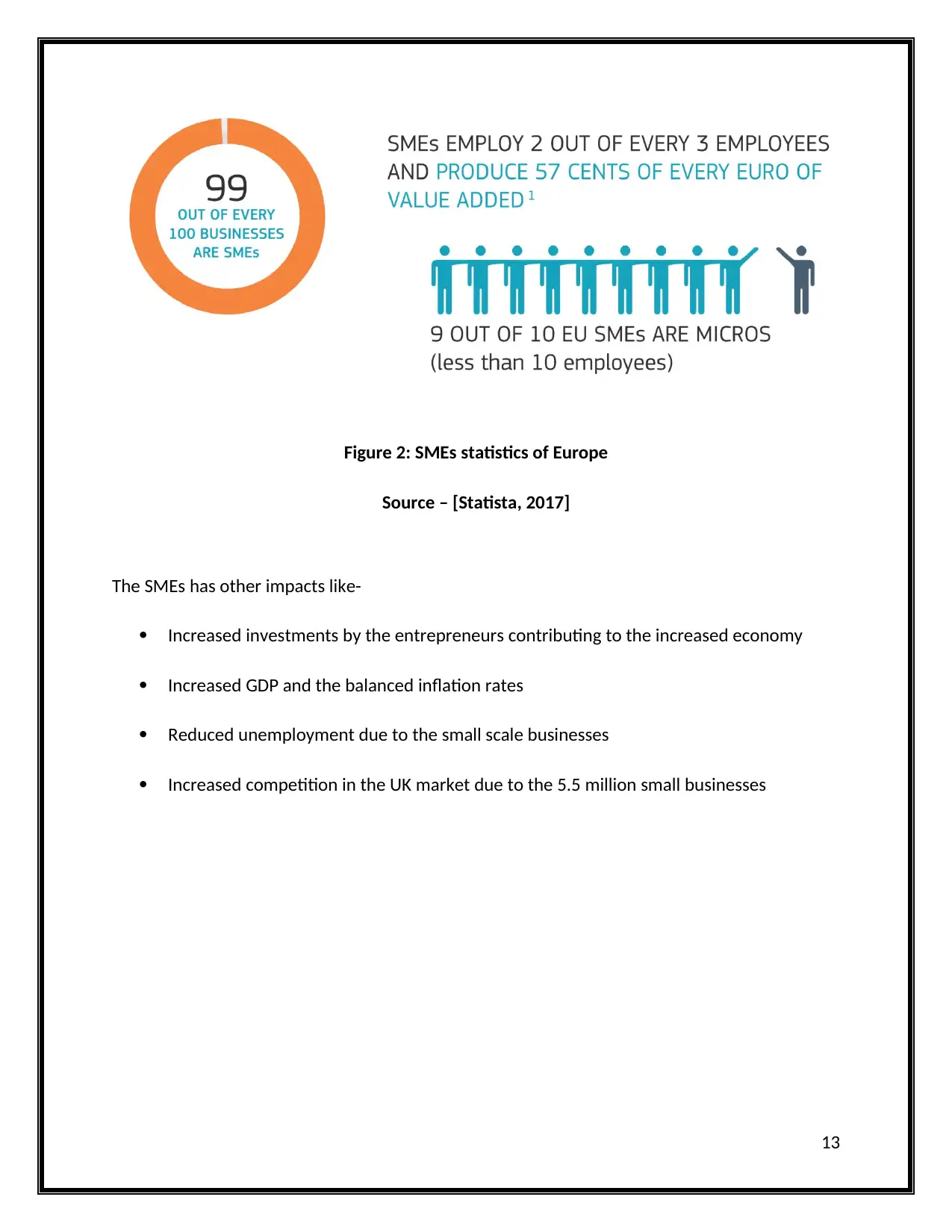
Figure 2: SMEs statistics of Europe
Source – [Statista, 2017]
The SMEs has other impacts like-
Increased investments by the entrepreneurs contributing to the increased economy
Increased GDP and the balanced inflation rates
Reduced unemployment due to the small scale businesses
Increased competition in the UK market due to the 5.5 million small businesses
13
Source – [Statista, 2017]
The SMEs has other impacts like-
Increased investments by the entrepreneurs contributing to the increased economy
Increased GDP and the balanced inflation rates
Reduced unemployment due to the small scale businesses
Increased competition in the UK market due to the 5.5 million small businesses
13
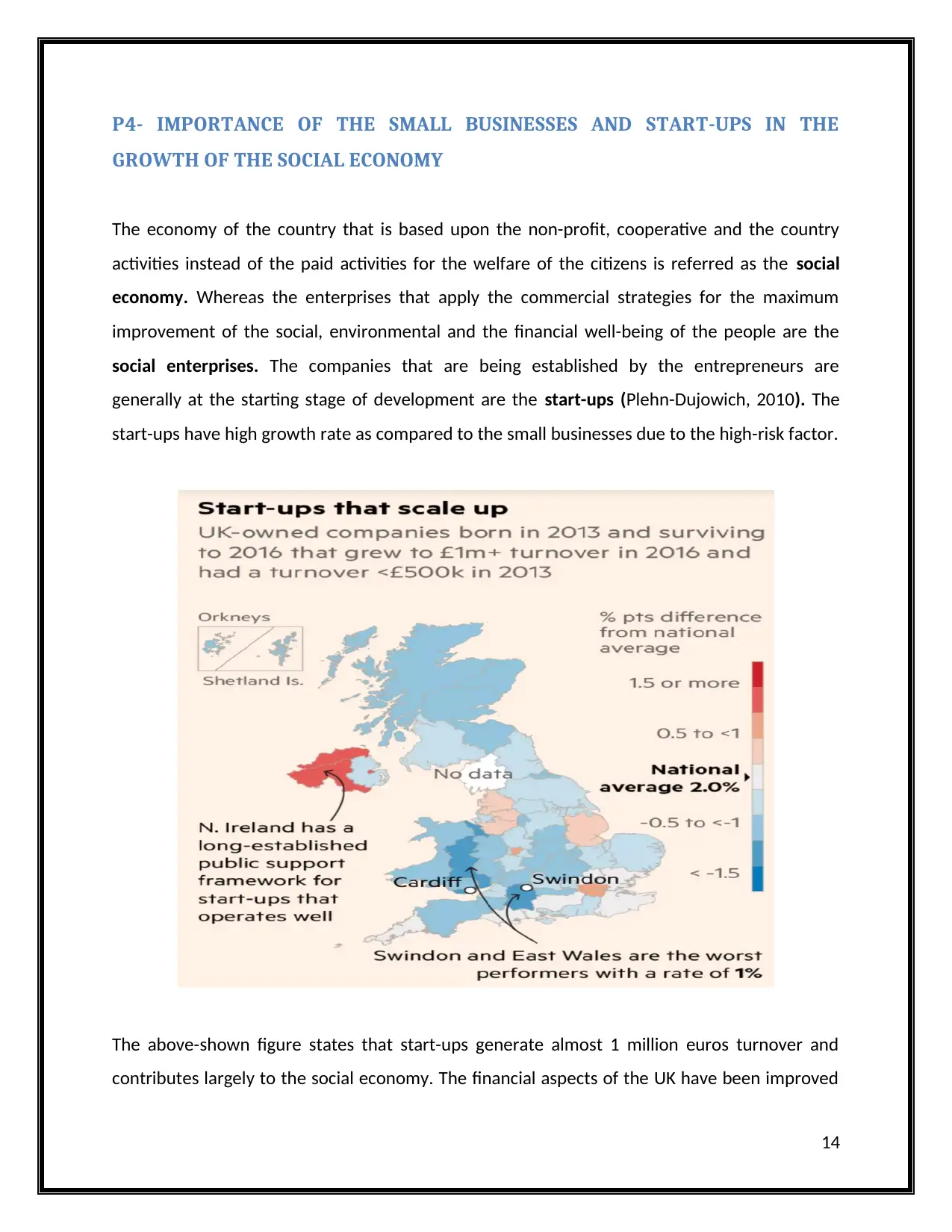
P4- IMPORTANCE OF THE SMALL BUSINESSES AND START-UPS IN THE
GROWTH OF THE SOCIAL ECONOMY
The economy of the country that is based upon the non-profit, cooperative and the country
activities instead of the paid activities for the welfare of the citizens is referred as the social
economy. Whereas the enterprises that apply the commercial strategies for the maximum
improvement of the social, environmental and the financial well-being of the people are the
social enterprises. The companies that are being established by the entrepreneurs are
generally at the starting stage of development are the start-ups (Plehn-Dujowich, 2010). The
start-ups have high growth rate as compared to the small businesses due to the high-risk factor.
The above-shown figure states that start-ups generate almost 1 million euros turnover and
contributes largely to the social economy. The financial aspects of the UK have been improved
14
GROWTH OF THE SOCIAL ECONOMY
The economy of the country that is based upon the non-profit, cooperative and the country
activities instead of the paid activities for the welfare of the citizens is referred as the social
economy. Whereas the enterprises that apply the commercial strategies for the maximum
improvement of the social, environmental and the financial well-being of the people are the
social enterprises. The companies that are being established by the entrepreneurs are
generally at the starting stage of development are the start-ups (Plehn-Dujowich, 2010). The
start-ups have high growth rate as compared to the small businesses due to the high-risk factor.
The above-shown figure states that start-ups generate almost 1 million euros turnover and
contributes largely to the social economy. The financial aspects of the UK have been improved
14
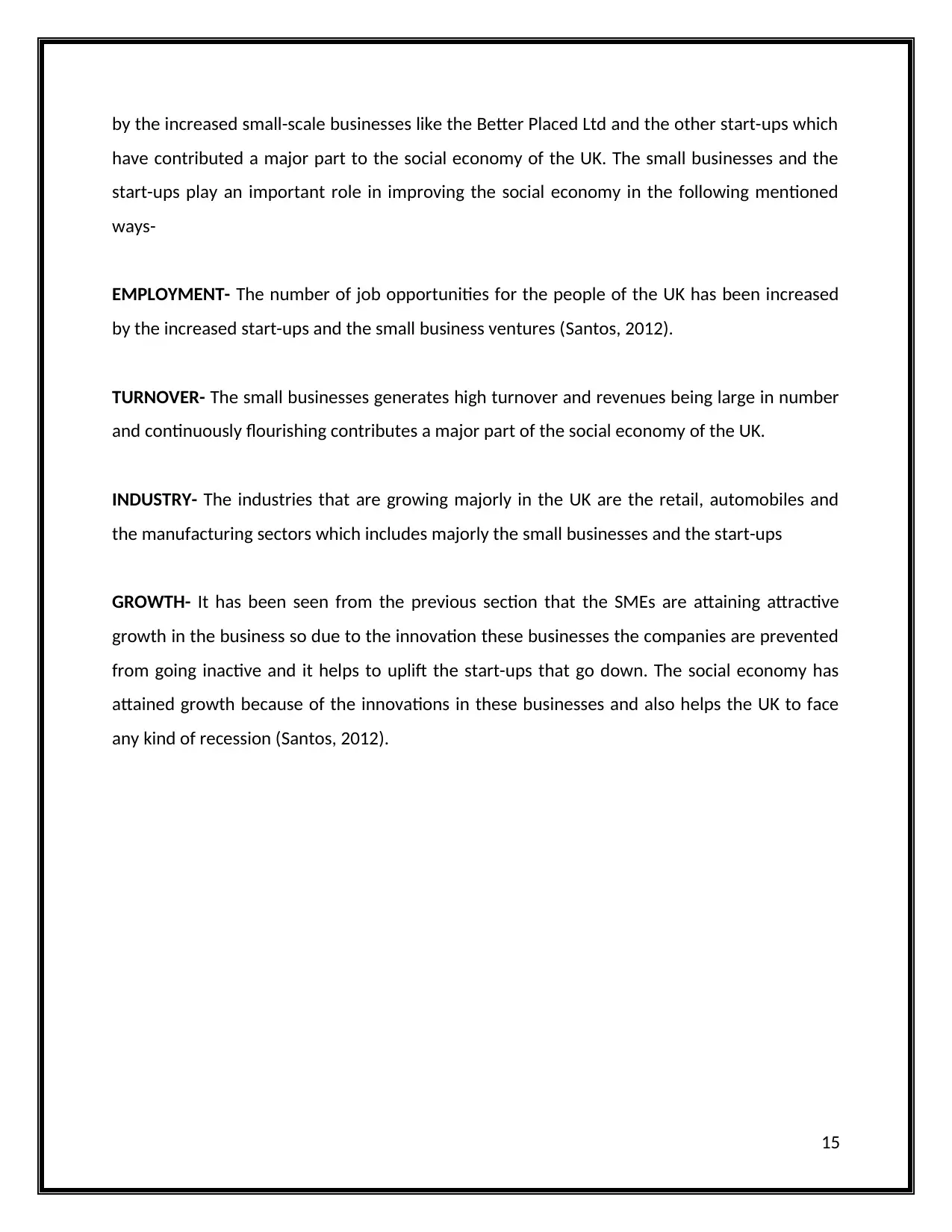
by the increased small-scale businesses like the Better Placed Ltd and the other start-ups which
have contributed a major part to the social economy of the UK. The small businesses and the
start-ups play an important role in improving the social economy in the following mentioned
ways-
EMPLOYMENT- The number of job opportunities for the people of the UK has been increased
by the increased start-ups and the small business ventures (Santos, 2012).
TURNOVER- The small businesses generates high turnover and revenues being large in number
and continuously flourishing contributes a major part of the social economy of the UK.
INDUSTRY- The industries that are growing majorly in the UK are the retail, automobiles and
the manufacturing sectors which includes majorly the small businesses and the start-ups
GROWTH- It has been seen from the previous section that the SMEs are attaining attractive
growth in the business so due to the innovation these businesses the companies are prevented
from going inactive and it helps to uplift the start-ups that go down. The social economy has
attained growth because of the innovations in these businesses and also helps the UK to face
any kind of recession (Santos, 2012).
15
have contributed a major part to the social economy of the UK. The small businesses and the
start-ups play an important role in improving the social economy in the following mentioned
ways-
EMPLOYMENT- The number of job opportunities for the people of the UK has been increased
by the increased start-ups and the small business ventures (Santos, 2012).
TURNOVER- The small businesses generates high turnover and revenues being large in number
and continuously flourishing contributes a major part of the social economy of the UK.
INDUSTRY- The industries that are growing majorly in the UK are the retail, automobiles and
the manufacturing sectors which includes majorly the small businesses and the start-ups
GROWTH- It has been seen from the previous section that the SMEs are attaining attractive
growth in the business so due to the innovation these businesses the companies are prevented
from going inactive and it helps to uplift the start-ups that go down. The social economy has
attained growth because of the innovations in these businesses and also helps the UK to face
any kind of recession (Santos, 2012).
15
Secure Best Marks with AI Grader
Need help grading? Try our AI Grader for instant feedback on your assignments.
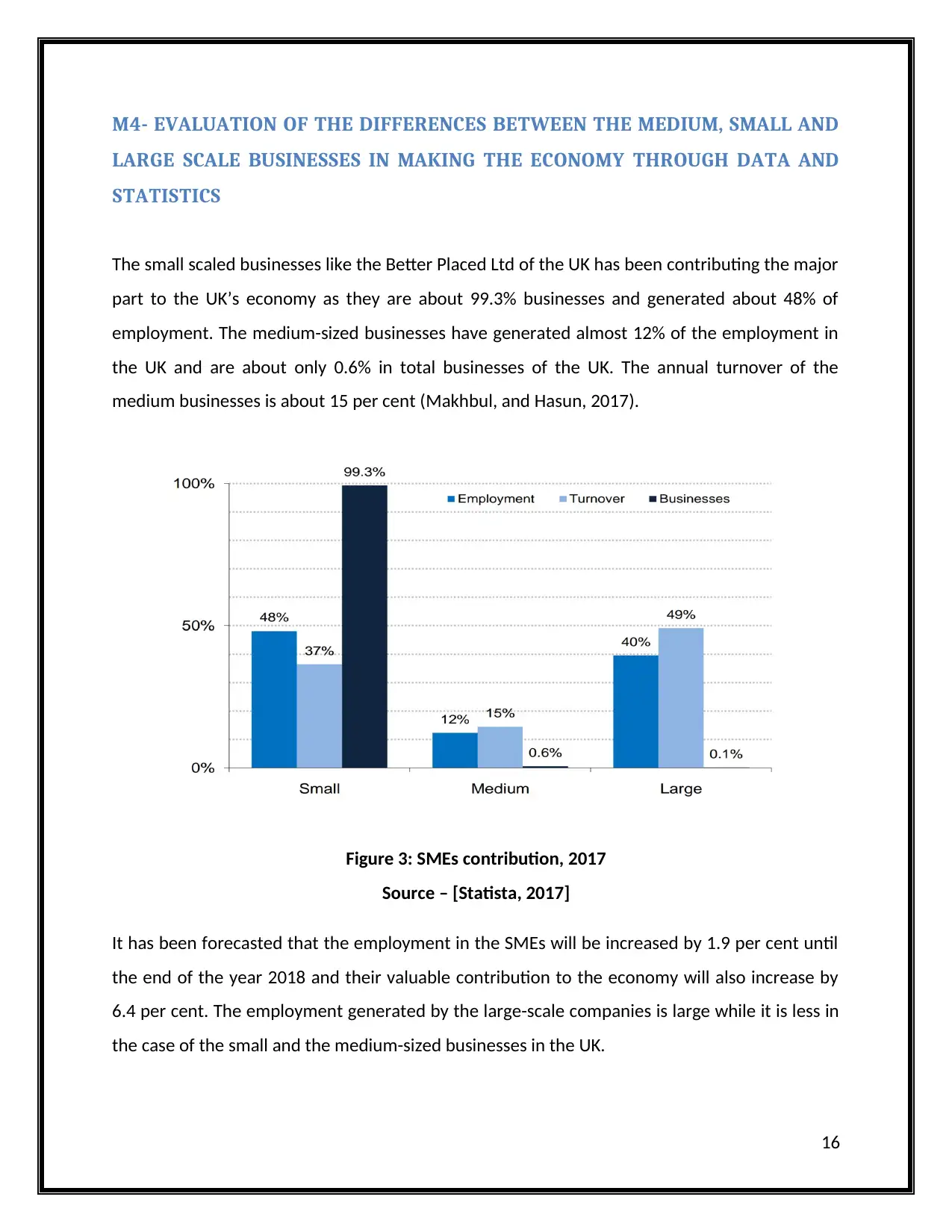
M4- EVALUATION OF THE DIFFERENCES BETWEEN THE MEDIUM, SMALL AND
LARGE SCALE BUSINESSES IN MAKING THE ECONOMY THROUGH DATA AND
STATISTICS
The small scaled businesses like the Better Placed Ltd of the UK has been contributing the major
part to the UK’s economy as they are about 99.3% businesses and generated about 48% of
employment. The medium-sized businesses have generated almost 12% of the employment in
the UK and are about only 0.6% in total businesses of the UK. The annual turnover of the
medium businesses is about 15 per cent (Makhbul, and Hasun, 2017).
Figure 3: SMEs contribution, 2017
Source – [Statista, 2017]
It has been forecasted that the employment in the SMEs will be increased by 1.9 per cent until
the end of the year 2018 and their valuable contribution to the economy will also increase by
6.4 per cent. The employment generated by the large-scale companies is large while it is less in
the case of the small and the medium-sized businesses in the UK.
16
LARGE SCALE BUSINESSES IN MAKING THE ECONOMY THROUGH DATA AND
STATISTICS
The small scaled businesses like the Better Placed Ltd of the UK has been contributing the major
part to the UK’s economy as they are about 99.3% businesses and generated about 48% of
employment. The medium-sized businesses have generated almost 12% of the employment in
the UK and are about only 0.6% in total businesses of the UK. The annual turnover of the
medium businesses is about 15 per cent (Makhbul, and Hasun, 2017).
Figure 3: SMEs contribution, 2017
Source – [Statista, 2017]
It has been forecasted that the employment in the SMEs will be increased by 1.9 per cent until
the end of the year 2018 and their valuable contribution to the economy will also increase by
6.4 per cent. The employment generated by the large-scale companies is large while it is less in
the case of the small and the medium-sized businesses in the UK.
16
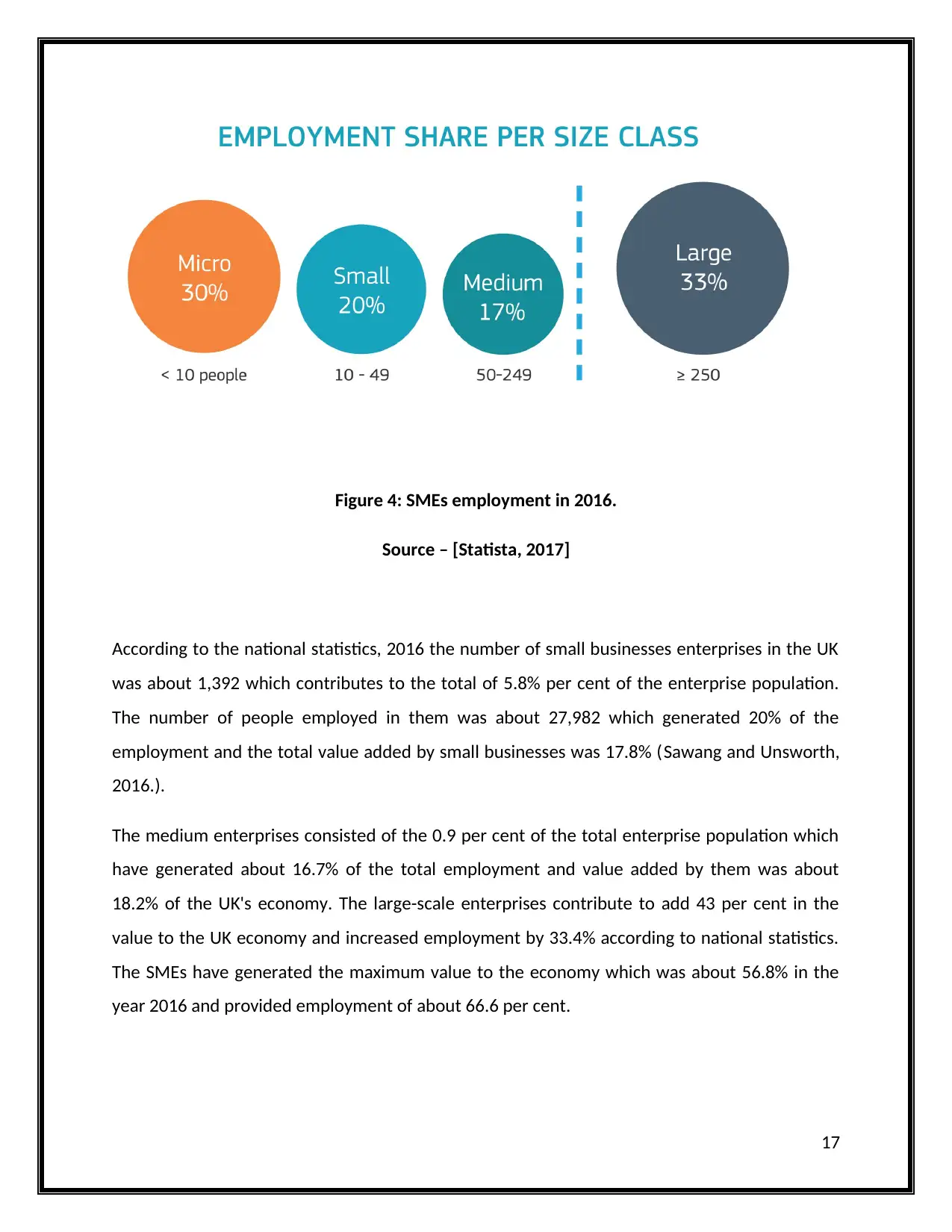
Figure 4: SMEs employment in 2016.
Source – [Statista, 2017]
According to the national statistics, 2016 the number of small businesses enterprises in the UK
was about 1,392 which contributes to the total of 5.8% per cent of the enterprise population.
The number of people employed in them was about 27,982 which generated 20% of the
employment and the total value added by small businesses was 17.8% (Sawang and Unsworth,
2016.).
The medium enterprises consisted of the 0.9 per cent of the total enterprise population which
have generated about 16.7% of the total employment and value added by them was about
18.2% of the UK's economy. The large-scale enterprises contribute to add 43 per cent in the
value to the UK economy and increased employment by 33.4% according to national statistics.
The SMEs have generated the maximum value to the economy which was about 56.8% in the
year 2016 and provided employment of about 66.6 per cent.
17
Source – [Statista, 2017]
According to the national statistics, 2016 the number of small businesses enterprises in the UK
was about 1,392 which contributes to the total of 5.8% per cent of the enterprise population.
The number of people employed in them was about 27,982 which generated 20% of the
employment and the total value added by small businesses was 17.8% (Sawang and Unsworth,
2016.).
The medium enterprises consisted of the 0.9 per cent of the total enterprise population which
have generated about 16.7% of the total employment and value added by them was about
18.2% of the UK's economy. The large-scale enterprises contribute to add 43 per cent in the
value to the UK economy and increased employment by 33.4% according to national statistics.
The SMEs have generated the maximum value to the economy which was about 56.8% in the
year 2016 and provided employment of about 66.6 per cent.
17
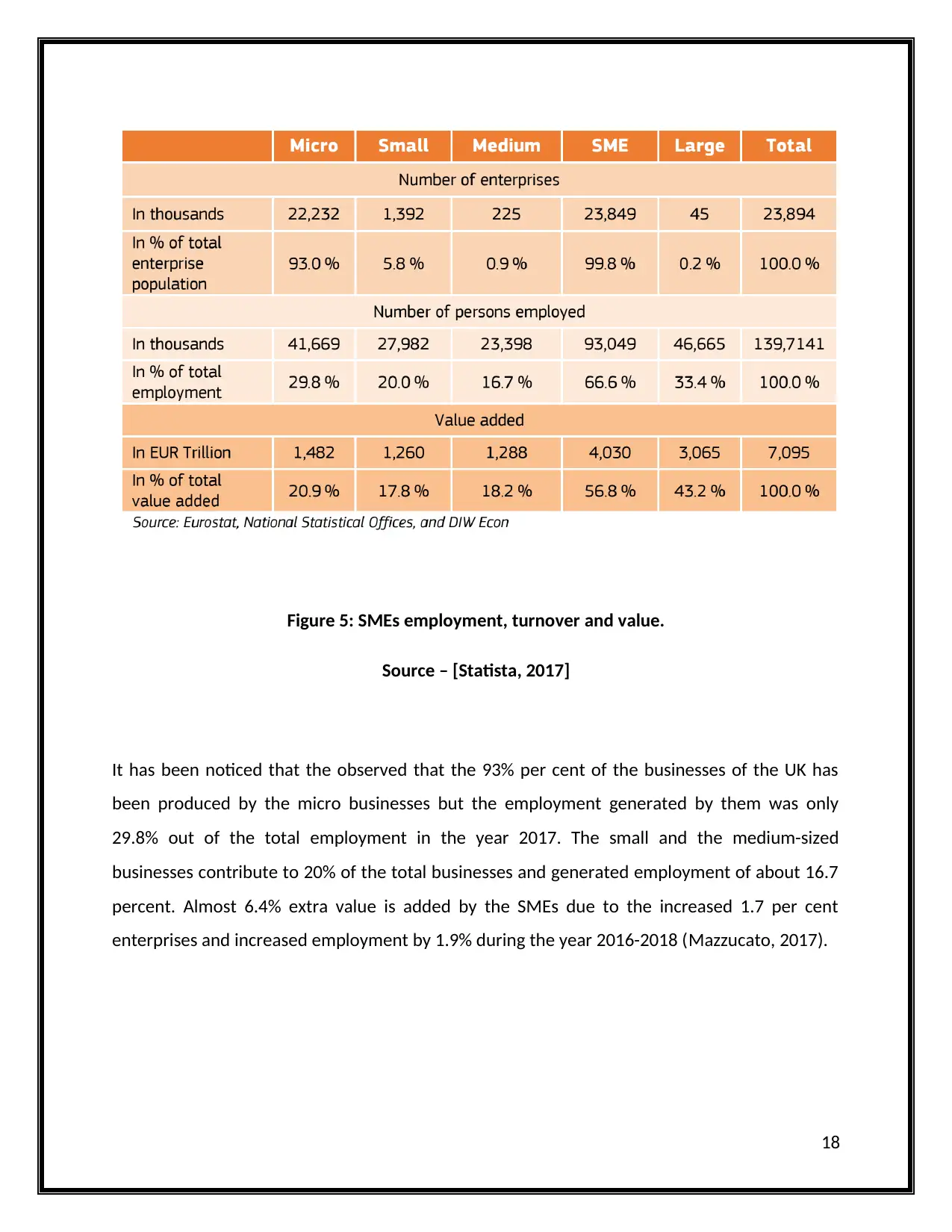
Figure 5: SMEs employment, turnover and value.
Source – [Statista, 2017]
It has been noticed that the observed that the 93% per cent of the businesses of the UK has
been produced by the micro businesses but the employment generated by them was only
29.8% out of the total employment in the year 2017. The small and the medium-sized
businesses contribute to 20% of the total businesses and generated employment of about 16.7
percent. Almost 6.4% extra value is added by the SMEs due to the increased 1.7 per cent
enterprises and increased employment by 1.9% during the year 2016-2018 (Mazzucato, 2017).
18
Source – [Statista, 2017]
It has been noticed that the observed that the 93% per cent of the businesses of the UK has
been produced by the micro businesses but the employment generated by them was only
29.8% out of the total employment in the year 2017. The small and the medium-sized
businesses contribute to 20% of the total businesses and generated employment of about 16.7
percent. Almost 6.4% extra value is added by the SMEs due to the increased 1.7 per cent
enterprises and increased employment by 1.9% during the year 2016-2018 (Mazzucato, 2017).
18
Paraphrase This Document
Need a fresh take? Get an instant paraphrase of this document with our AI Paraphraser
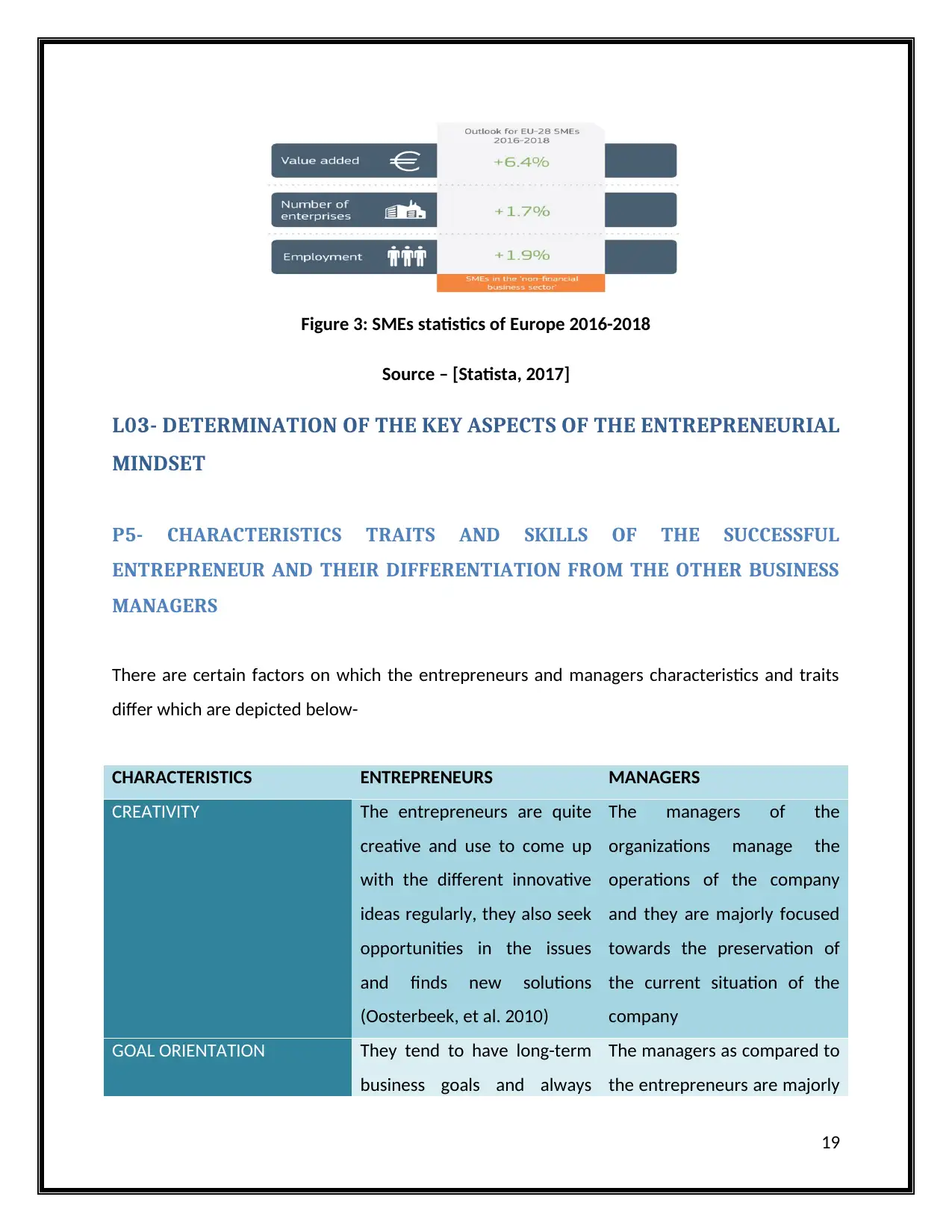
Figure 3: SMEs statistics of Europe 2016-2018
Source – [Statista, 2017]
L03- DETERMINATION OF THE KEY ASPECTS OF THE ENTREPRENEURIAL
MINDSET
P5- CHARACTERISTICS TRAITS AND SKILLS OF THE SUCCESSFUL
ENTREPRENEUR AND THEIR DIFFERENTIATION FROM THE OTHER BUSINESS
MANAGERS
There are certain factors on which the entrepreneurs and managers characteristics and traits
differ which are depicted below-
CHARACTERISTICS ENTREPRENEURS MANAGERS
CREATIVITY The entrepreneurs are quite
creative and use to come up
with the different innovative
ideas regularly, they also seek
opportunities in the issues
and finds new solutions
(Oosterbeek, et al. 2010)
The managers of the
organizations manage the
operations of the company
and they are majorly focused
towards the preservation of
the current situation of the
company
GOAL ORIENTATION They tend to have long-term
business goals and always
The managers as compared to
the entrepreneurs are majorly
19
Source – [Statista, 2017]
L03- DETERMINATION OF THE KEY ASPECTS OF THE ENTREPRENEURIAL
MINDSET
P5- CHARACTERISTICS TRAITS AND SKILLS OF THE SUCCESSFUL
ENTREPRENEUR AND THEIR DIFFERENTIATION FROM THE OTHER BUSINESS
MANAGERS
There are certain factors on which the entrepreneurs and managers characteristics and traits
differ which are depicted below-
CHARACTERISTICS ENTREPRENEURS MANAGERS
CREATIVITY The entrepreneurs are quite
creative and use to come up
with the different innovative
ideas regularly, they also seek
opportunities in the issues
and finds new solutions
(Oosterbeek, et al. 2010)
The managers of the
organizations manage the
operations of the company
and they are majorly focused
towards the preservation of
the current situation of the
company
GOAL ORIENTATION They tend to have long-term
business goals and always
The managers as compared to
the entrepreneurs are majorly
19
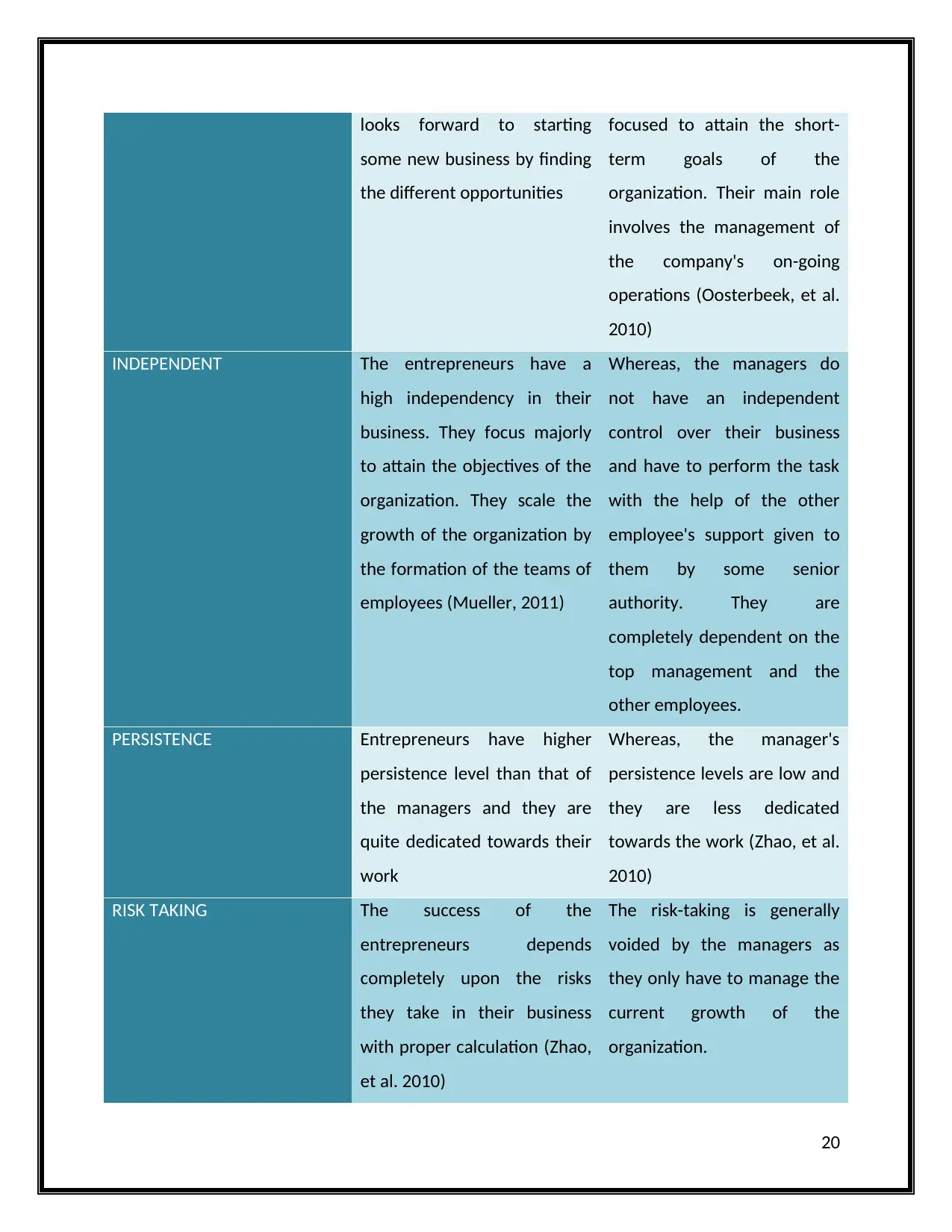
looks forward to starting
some new business by finding
the different opportunities
focused to attain the short-
term goals of the
organization. Their main role
involves the management of
the company's on-going
operations (Oosterbeek, et al.
2010)
INDEPENDENT The entrepreneurs have a
high independency in their
business. They focus majorly
to attain the objectives of the
organization. They scale the
growth of the organization by
the formation of the teams of
employees (Mueller, 2011)
Whereas, the managers do
not have an independent
control over their business
and have to perform the task
with the help of the other
employee's support given to
them by some senior
authority. They are
completely dependent on the
top management and the
other employees.
PERSISTENCE Entrepreneurs have higher
persistence level than that of
the managers and they are
quite dedicated towards their
work
Whereas, the manager's
persistence levels are low and
they are less dedicated
towards the work (Zhao, et al.
2010)
RISK TAKING The success of the
entrepreneurs depends
completely upon the risks
they take in their business
with proper calculation (Zhao,
et al. 2010)
The risk-taking is generally
voided by the managers as
they only have to manage the
current growth of the
organization.
20
some new business by finding
the different opportunities
focused to attain the short-
term goals of the
organization. Their main role
involves the management of
the company's on-going
operations (Oosterbeek, et al.
2010)
INDEPENDENT The entrepreneurs have a
high independency in their
business. They focus majorly
to attain the objectives of the
organization. They scale the
growth of the organization by
the formation of the teams of
employees (Mueller, 2011)
Whereas, the managers do
not have an independent
control over their business
and have to perform the task
with the help of the other
employee's support given to
them by some senior
authority. They are
completely dependent on the
top management and the
other employees.
PERSISTENCE Entrepreneurs have higher
persistence level than that of
the managers and they are
quite dedicated towards their
work
Whereas, the manager's
persistence levels are low and
they are less dedicated
towards the work (Zhao, et al.
2010)
RISK TAKING The success of the
entrepreneurs depends
completely upon the risks
they take in their business
with proper calculation (Zhao,
et al. 2010)
The risk-taking is generally
voided by the managers as
they only have to manage the
current growth of the
organization.
20
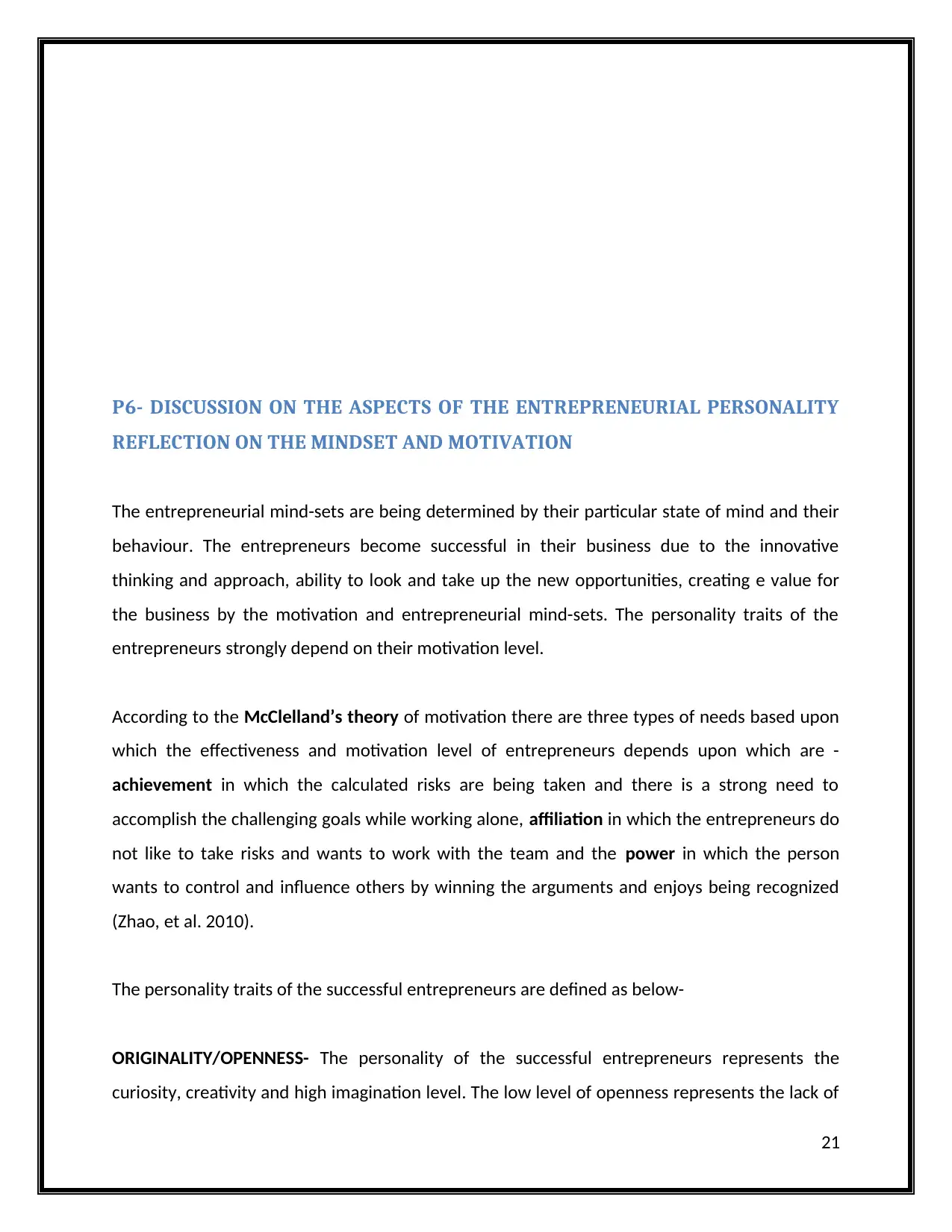
P6- DISCUSSION ON THE ASPECTS OF THE ENTREPRENEURIAL PERSONALITY
REFLECTION ON THE MINDSET AND MOTIVATION
The entrepreneurial mind-sets are being determined by their particular state of mind and their
behaviour. The entrepreneurs become successful in their business due to the innovative
thinking and approach, ability to look and take up the new opportunities, creating e value for
the business by the motivation and entrepreneurial mind-sets. The personality traits of the
entrepreneurs strongly depend on their motivation level.
According to the McClelland’s theory of motivation there are three types of needs based upon
which the effectiveness and motivation level of entrepreneurs depends upon which are -
achievement in which the calculated risks are being taken and there is a strong need to
accomplish the challenging goals while working alone, affiliation in which the entrepreneurs do
not like to take risks and wants to work with the team and the power in which the person
wants to control and influence others by winning the arguments and enjoys being recognized
(Zhao, et al. 2010).
The personality traits of the successful entrepreneurs are defined as below-
ORIGINALITY/OPENNESS- The personality of the successful entrepreneurs represents the
curiosity, creativity and high imagination level. The low level of openness represents the lack of
21
REFLECTION ON THE MINDSET AND MOTIVATION
The entrepreneurial mind-sets are being determined by their particular state of mind and their
behaviour. The entrepreneurs become successful in their business due to the innovative
thinking and approach, ability to look and take up the new opportunities, creating e value for
the business by the motivation and entrepreneurial mind-sets. The personality traits of the
entrepreneurs strongly depend on their motivation level.
According to the McClelland’s theory of motivation there are three types of needs based upon
which the effectiveness and motivation level of entrepreneurs depends upon which are -
achievement in which the calculated risks are being taken and there is a strong need to
accomplish the challenging goals while working alone, affiliation in which the entrepreneurs do
not like to take risks and wants to work with the team and the power in which the person
wants to control and influence others by winning the arguments and enjoys being recognized
(Zhao, et al. 2010).
The personality traits of the successful entrepreneurs are defined as below-
ORIGINALITY/OPENNESS- The personality of the successful entrepreneurs represents the
curiosity, creativity and high imagination level. The low level of openness represents the lack of
21
Secure Best Marks with AI Grader
Need help grading? Try our AI Grader for instant feedback on your assignments.
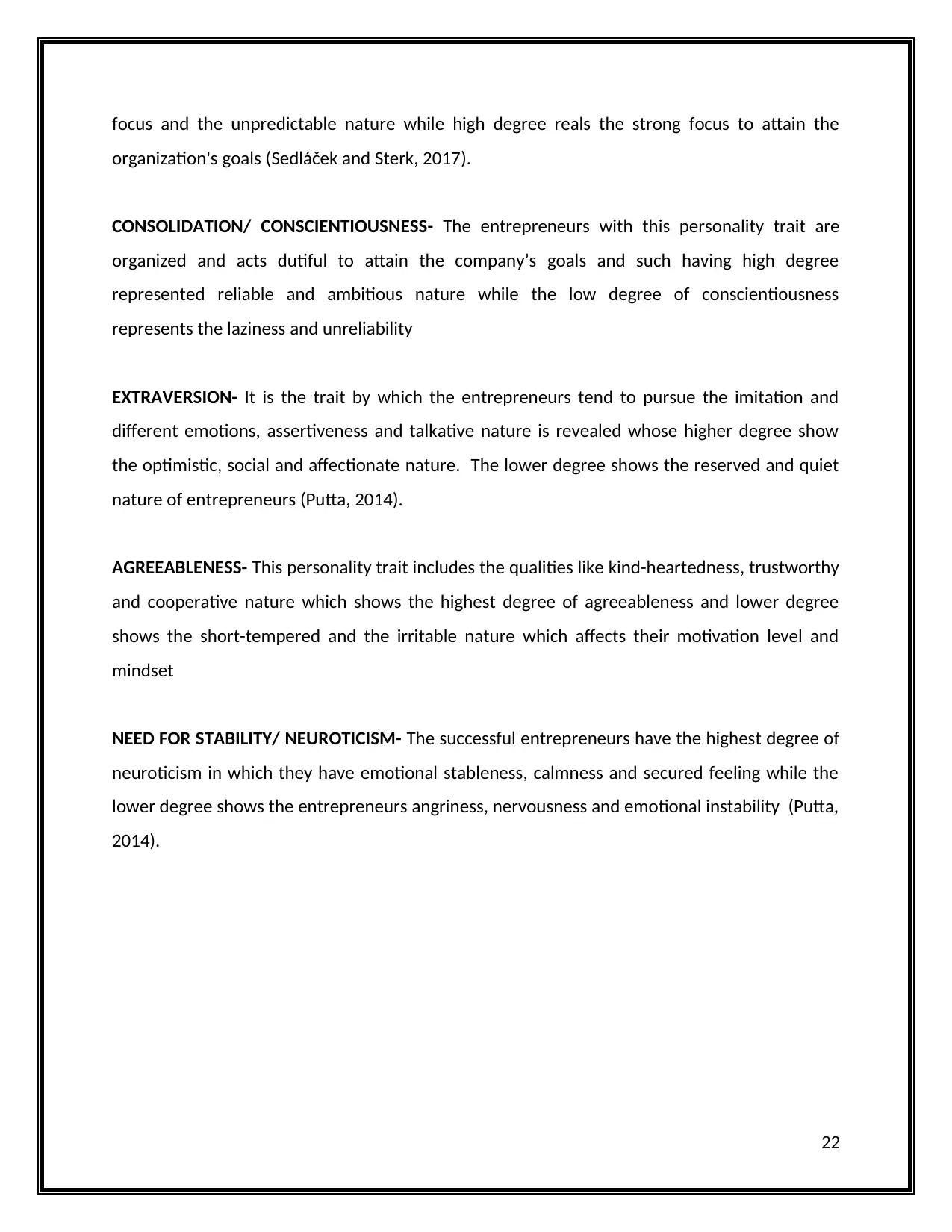
focus and the unpredictable nature while high degree reals the strong focus to attain the
organization's goals (Sedláček and Sterk, 2017).
CONSOLIDATION/ CONSCIENTIOUSNESS- The entrepreneurs with this personality trait are
organized and acts dutiful to attain the company’s goals and such having high degree
represented reliable and ambitious nature while the low degree of conscientiousness
represents the laziness and unreliability
EXTRAVERSION- It is the trait by which the entrepreneurs tend to pursue the imitation and
different emotions, assertiveness and talkative nature is revealed whose higher degree show
the optimistic, social and affectionate nature. The lower degree shows the reserved and quiet
nature of entrepreneurs (Putta, 2014).
AGREEABLENESS- This personality trait includes the qualities like kind-heartedness, trustworthy
and cooperative nature which shows the highest degree of agreeableness and lower degree
shows the short-tempered and the irritable nature which affects their motivation level and
mindset
NEED FOR STABILITY/ NEUROTICISM- The successful entrepreneurs have the highest degree of
neuroticism in which they have emotional stableness, calmness and secured feeling while the
lower degree shows the entrepreneurs angriness, nervousness and emotional instability (Putta,
2014).
22
organization's goals (Sedláček and Sterk, 2017).
CONSOLIDATION/ CONSCIENTIOUSNESS- The entrepreneurs with this personality trait are
organized and acts dutiful to attain the company’s goals and such having high degree
represented reliable and ambitious nature while the low degree of conscientiousness
represents the laziness and unreliability
EXTRAVERSION- It is the trait by which the entrepreneurs tend to pursue the imitation and
different emotions, assertiveness and talkative nature is revealed whose higher degree show
the optimistic, social and affectionate nature. The lower degree shows the reserved and quiet
nature of entrepreneurs (Putta, 2014).
AGREEABLENESS- This personality trait includes the qualities like kind-heartedness, trustworthy
and cooperative nature which shows the highest degree of agreeableness and lower degree
shows the short-tempered and the irritable nature which affects their motivation level and
mindset
NEED FOR STABILITY/ NEUROTICISM- The successful entrepreneurs have the highest degree of
neuroticism in which they have emotional stableness, calmness and secured feeling while the
lower degree shows the entrepreneurs angriness, nervousness and emotional instability (Putta,
2014).
22
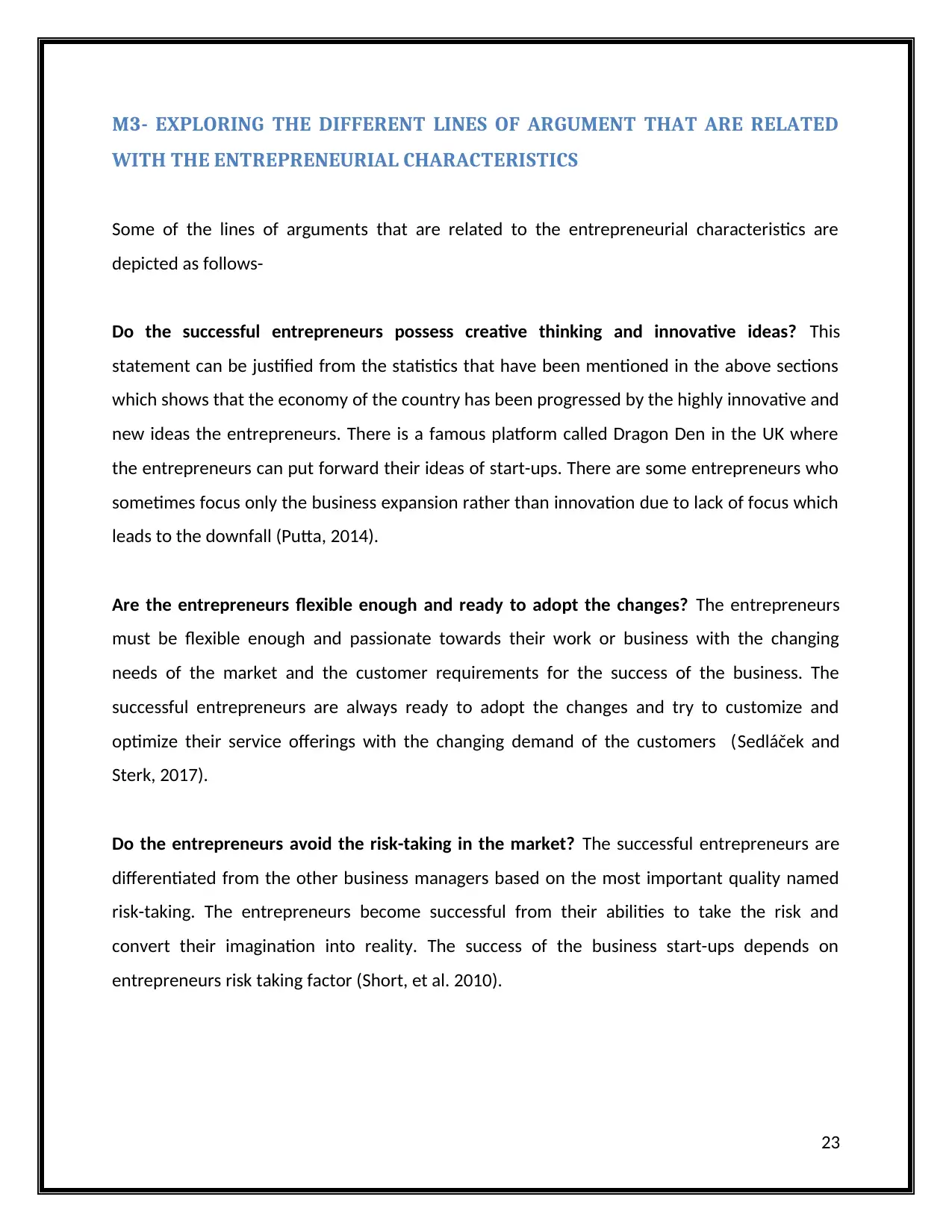
M3- EXPLORING THE DIFFERENT LINES OF ARGUMENT THAT ARE RELATED
WITH THE ENTREPRENEURIAL CHARACTERISTICS
Some of the lines of arguments that are related to the entrepreneurial characteristics are
depicted as follows-
Do the successful entrepreneurs possess creative thinking and innovative ideas? This
statement can be justified from the statistics that have been mentioned in the above sections
which shows that the economy of the country has been progressed by the highly innovative and
new ideas the entrepreneurs. There is a famous platform called Dragon Den in the UK where
the entrepreneurs can put forward their ideas of start-ups. There are some entrepreneurs who
sometimes focus only the business expansion rather than innovation due to lack of focus which
leads to the downfall (Putta, 2014).
Are the entrepreneurs flexible enough and ready to adopt the changes? The entrepreneurs
must be flexible enough and passionate towards their work or business with the changing
needs of the market and the customer requirements for the success of the business. The
successful entrepreneurs are always ready to adopt the changes and try to customize and
optimize their service offerings with the changing demand of the customers (Sedláček and
Sterk, 2017).
Do the entrepreneurs avoid the risk-taking in the market? The successful entrepreneurs are
differentiated from the other business managers based on the most important quality named
risk-taking. The entrepreneurs become successful from their abilities to take the risk and
convert their imagination into reality. The success of the business start-ups depends on
entrepreneurs risk taking factor (Short, et al. 2010).
23
WITH THE ENTREPRENEURIAL CHARACTERISTICS
Some of the lines of arguments that are related to the entrepreneurial characteristics are
depicted as follows-
Do the successful entrepreneurs possess creative thinking and innovative ideas? This
statement can be justified from the statistics that have been mentioned in the above sections
which shows that the economy of the country has been progressed by the highly innovative and
new ideas the entrepreneurs. There is a famous platform called Dragon Den in the UK where
the entrepreneurs can put forward their ideas of start-ups. There are some entrepreneurs who
sometimes focus only the business expansion rather than innovation due to lack of focus which
leads to the downfall (Putta, 2014).
Are the entrepreneurs flexible enough and ready to adopt the changes? The entrepreneurs
must be flexible enough and passionate towards their work or business with the changing
needs of the market and the customer requirements for the success of the business. The
successful entrepreneurs are always ready to adopt the changes and try to customize and
optimize their service offerings with the changing demand of the customers (Sedláček and
Sterk, 2017).
Do the entrepreneurs avoid the risk-taking in the market? The successful entrepreneurs are
differentiated from the other business managers based on the most important quality named
risk-taking. The entrepreneurs become successful from their abilities to take the risk and
convert their imagination into reality. The success of the business start-ups depends on
entrepreneurs risk taking factor (Short, et al. 2010).
23
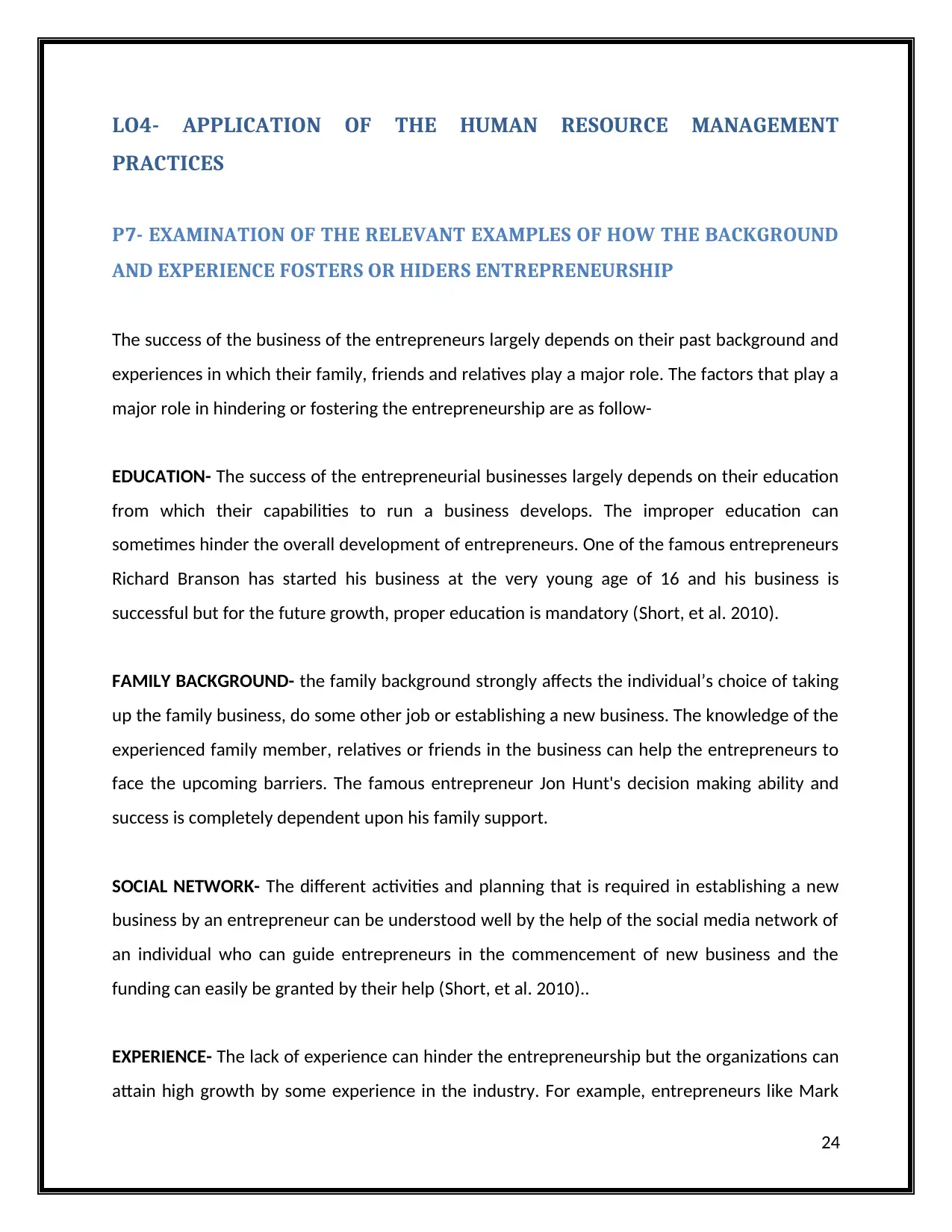
LO4- APPLICATION OF THE HUMAN RESOURCE MANAGEMENT
PRACTICES
P7- EXAMINATION OF THE RELEVANT EXAMPLES OF HOW THE BACKGROUND
AND EXPERIENCE FOSTERS OR HIDERS ENTREPRENEURSHIP
The success of the business of the entrepreneurs largely depends on their past background and
experiences in which their family, friends and relatives play a major role. The factors that play a
major role in hindering or fostering the entrepreneurship are as follow-
EDUCATION- The success of the entrepreneurial businesses largely depends on their education
from which their capabilities to run a business develops. The improper education can
sometimes hinder the overall development of entrepreneurs. One of the famous entrepreneurs
Richard Branson has started his business at the very young age of 16 and his business is
successful but for the future growth, proper education is mandatory (Short, et al. 2010).
FAMILY BACKGROUND- the family background strongly affects the individual’s choice of taking
up the family business, do some other job or establishing a new business. The knowledge of the
experienced family member, relatives or friends in the business can help the entrepreneurs to
face the upcoming barriers. The famous entrepreneur Jon Hunt's decision making ability and
success is completely dependent upon his family support.
SOCIAL NETWORK- The different activities and planning that is required in establishing a new
business by an entrepreneur can be understood well by the help of the social media network of
an individual who can guide entrepreneurs in the commencement of new business and the
funding can easily be granted by their help (Short, et al. 2010)..
EXPERIENCE- The lack of experience can hinder the entrepreneurship but the organizations can
attain high growth by some experience in the industry. For example, entrepreneurs like Mark
24
PRACTICES
P7- EXAMINATION OF THE RELEVANT EXAMPLES OF HOW THE BACKGROUND
AND EXPERIENCE FOSTERS OR HIDERS ENTREPRENEURSHIP
The success of the business of the entrepreneurs largely depends on their past background and
experiences in which their family, friends and relatives play a major role. The factors that play a
major role in hindering or fostering the entrepreneurship are as follow-
EDUCATION- The success of the entrepreneurial businesses largely depends on their education
from which their capabilities to run a business develops. The improper education can
sometimes hinder the overall development of entrepreneurs. One of the famous entrepreneurs
Richard Branson has started his business at the very young age of 16 and his business is
successful but for the future growth, proper education is mandatory (Short, et al. 2010).
FAMILY BACKGROUND- the family background strongly affects the individual’s choice of taking
up the family business, do some other job or establishing a new business. The knowledge of the
experienced family member, relatives or friends in the business can help the entrepreneurs to
face the upcoming barriers. The famous entrepreneur Jon Hunt's decision making ability and
success is completely dependent upon his family support.
SOCIAL NETWORK- The different activities and planning that is required in establishing a new
business by an entrepreneur can be understood well by the help of the social media network of
an individual who can guide entrepreneurs in the commencement of new business and the
funding can easily be granted by their help (Short, et al. 2010)..
EXPERIENCE- The lack of experience can hinder the entrepreneurship but the organizations can
attain high growth by some experience in the industry. For example, entrepreneurs like Mark
24
Paraphrase This Document
Need a fresh take? Get an instant paraphrase of this document with our AI Paraphraser

Zuckerberg who has established his organization Facebook without any prior knowledge was
not very successful at the initial days but with the increased experience his business is one of
the most popular in the world. The bad experience can lead to the downfall but good
experience can lead to the high success and growth in the business (Zhao, et al. 2010).
25
not very successful at the initial days but with the increased experience his business is one of
the most popular in the world. The bad experience can lead to the downfall but good
experience can lead to the high success and growth in the business (Zhao, et al. 2010).
25
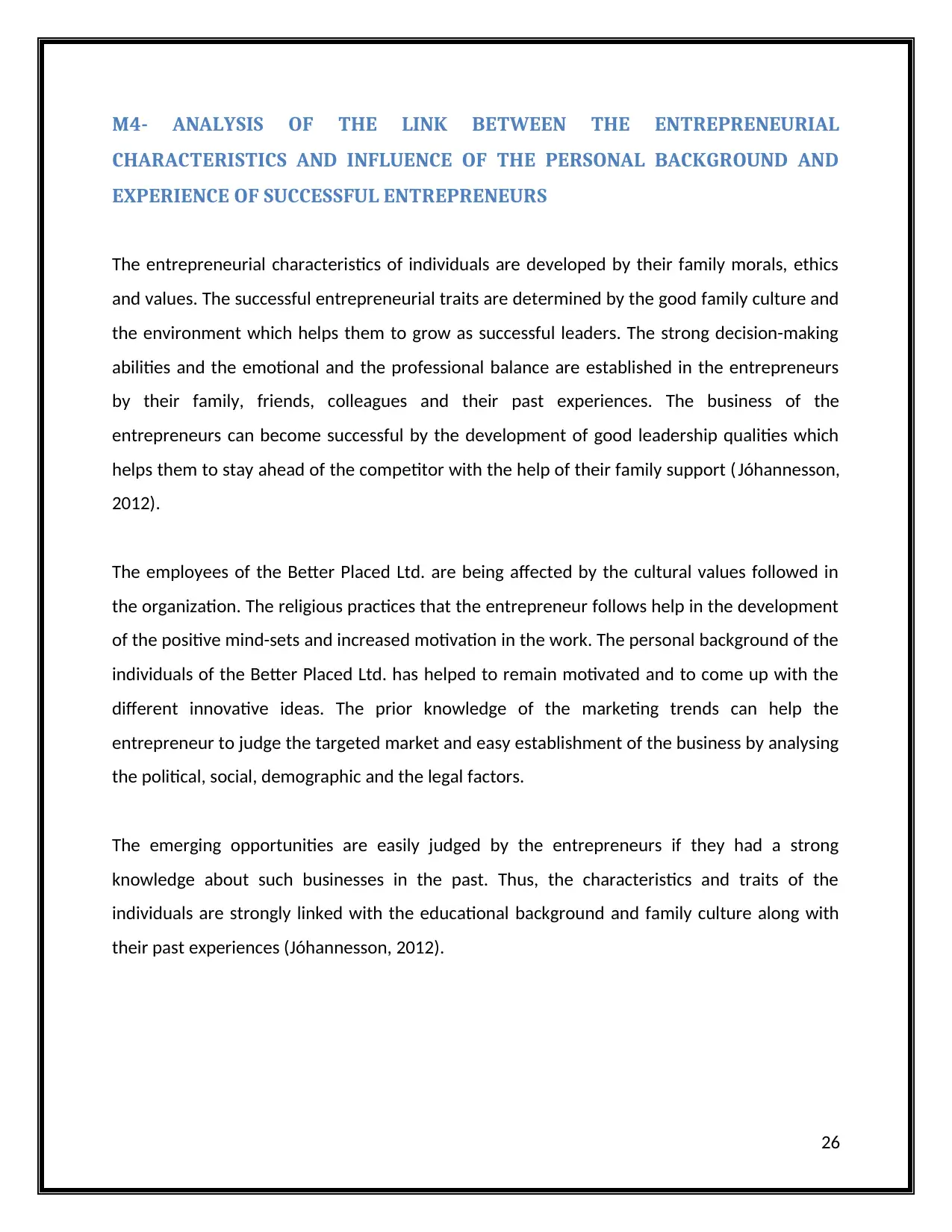
M4- ANALYSIS OF THE LINK BETWEEN THE ENTREPRENEURIAL
CHARACTERISTICS AND INFLUENCE OF THE PERSONAL BACKGROUND AND
EXPERIENCE OF SUCCESSFUL ENTREPRENEURS
The entrepreneurial characteristics of individuals are developed by their family morals, ethics
and values. The successful entrepreneurial traits are determined by the good family culture and
the environment which helps them to grow as successful leaders. The strong decision-making
abilities and the emotional and the professional balance are established in the entrepreneurs
by their family, friends, colleagues and their past experiences. The business of the
entrepreneurs can become successful by the development of good leadership qualities which
helps them to stay ahead of the competitor with the help of their family support ( Jóhannesson,
2012).
The employees of the Better Placed Ltd. are being affected by the cultural values followed in
the organization. The religious practices that the entrepreneur follows help in the development
of the positive mind-sets and increased motivation in the work. The personal background of the
individuals of the Better Placed Ltd. has helped to remain motivated and to come up with the
different innovative ideas. The prior knowledge of the marketing trends can help the
entrepreneur to judge the targeted market and easy establishment of the business by analysing
the political, social, demographic and the legal factors.
The emerging opportunities are easily judged by the entrepreneurs if they had a strong
knowledge about such businesses in the past. Thus, the characteristics and traits of the
individuals are strongly linked with the educational background and family culture along with
their past experiences (Jóhannesson, 2012).
26
CHARACTERISTICS AND INFLUENCE OF THE PERSONAL BACKGROUND AND
EXPERIENCE OF SUCCESSFUL ENTREPRENEURS
The entrepreneurial characteristics of individuals are developed by their family morals, ethics
and values. The successful entrepreneurial traits are determined by the good family culture and
the environment which helps them to grow as successful leaders. The strong decision-making
abilities and the emotional and the professional balance are established in the entrepreneurs
by their family, friends, colleagues and their past experiences. The business of the
entrepreneurs can become successful by the development of good leadership qualities which
helps them to stay ahead of the competitor with the help of their family support ( Jóhannesson,
2012).
The employees of the Better Placed Ltd. are being affected by the cultural values followed in
the organization. The religious practices that the entrepreneur follows help in the development
of the positive mind-sets and increased motivation in the work. The personal background of the
individuals of the Better Placed Ltd. has helped to remain motivated and to come up with the
different innovative ideas. The prior knowledge of the marketing trends can help the
entrepreneur to judge the targeted market and easy establishment of the business by analysing
the political, social, demographic and the legal factors.
The emerging opportunities are easily judged by the entrepreneurs if they had a strong
knowledge about such businesses in the past. Thus, the characteristics and traits of the
individuals are strongly linked with the educational background and family culture along with
their past experiences (Jóhannesson, 2012).
26
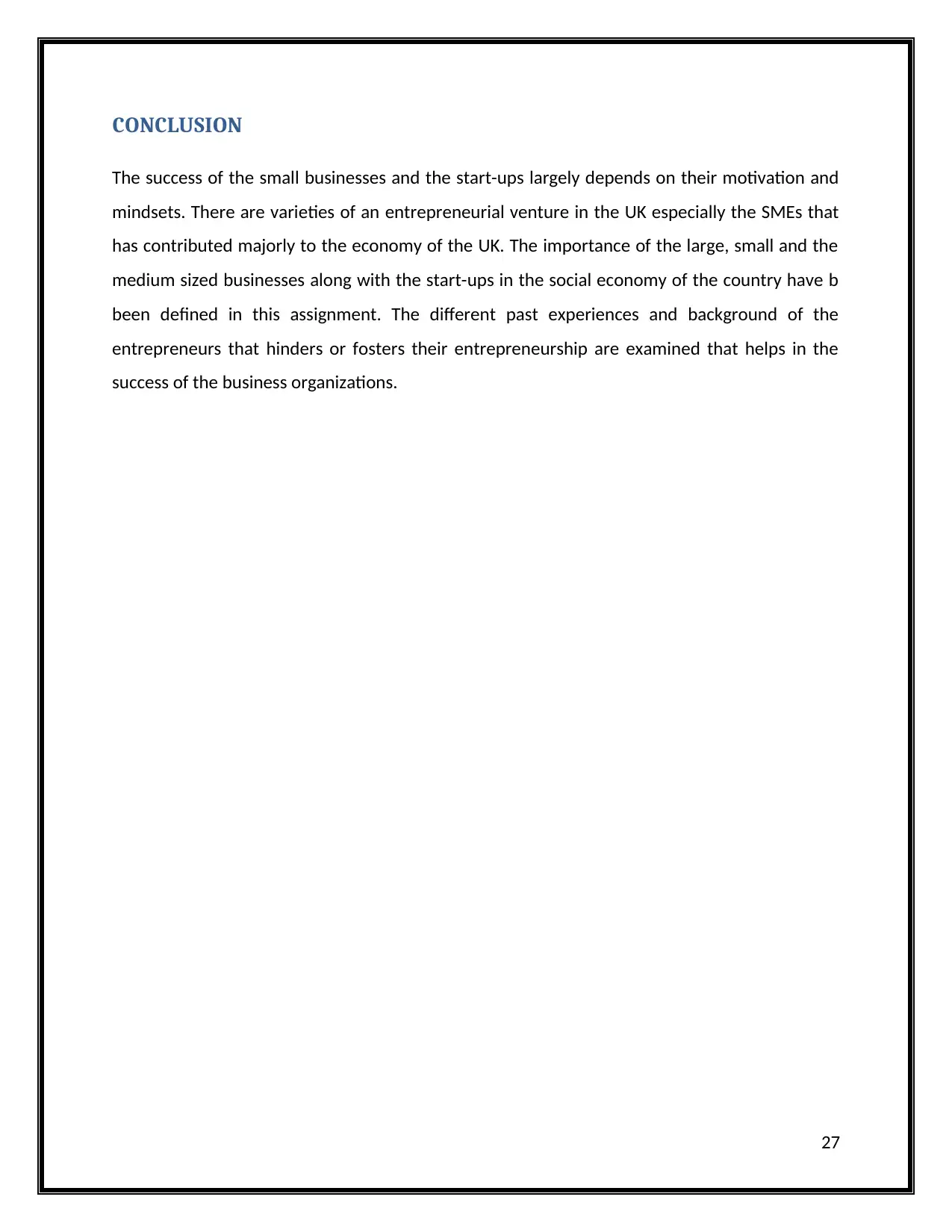
CONCLUSION
The success of the small businesses and the start-ups largely depends on their motivation and
mindsets. There are varieties of an entrepreneurial venture in the UK especially the SMEs that
has contributed majorly to the economy of the UK. The importance of the large, small and the
medium sized businesses along with the start-ups in the social economy of the country have b
been defined in this assignment. The different past experiences and background of the
entrepreneurs that hinders or fosters their entrepreneurship are examined that helps in the
success of the business organizations.
27
The success of the small businesses and the start-ups largely depends on their motivation and
mindsets. There are varieties of an entrepreneurial venture in the UK especially the SMEs that
has contributed majorly to the economy of the UK. The importance of the large, small and the
medium sized businesses along with the start-ups in the social economy of the country have b
been defined in this assignment. The different past experiences and background of the
entrepreneurs that hinders or fosters their entrepreneurship are examined that helps in the
success of the business organizations.
27
Secure Best Marks with AI Grader
Need help grading? Try our AI Grader for instant feedback on your assignments.
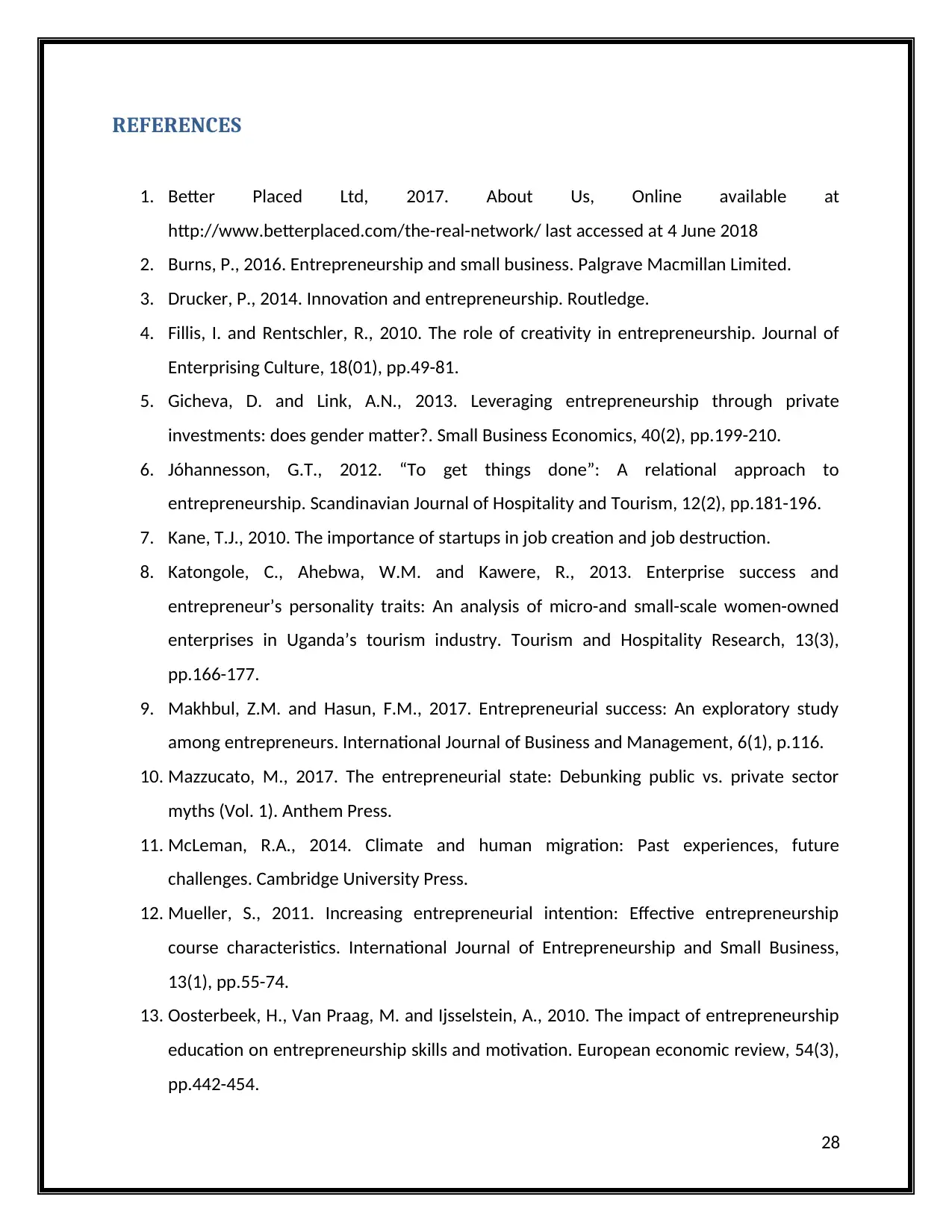
REFERENCES
1. Better Placed Ltd, 2017. About Us, Online available at
http://www.betterplaced.com/the-real-network/ last accessed at 4 June 2018
2. Burns, P., 2016. Entrepreneurship and small business. Palgrave Macmillan Limited.
3. Drucker, P., 2014. Innovation and entrepreneurship. Routledge.
4. Fillis, I. and Rentschler, R., 2010. The role of creativity in entrepreneurship. Journal of
Enterprising Culture, 18(01), pp.49-81.
5. Gicheva, D. and Link, A.N., 2013. Leveraging entrepreneurship through private
investments: does gender matter?. Small Business Economics, 40(2), pp.199-210.
6. Jóhannesson, G.T., 2012. “To get things done”: A relational approach to
entrepreneurship. Scandinavian Journal of Hospitality and Tourism, 12(2), pp.181-196.
7. Kane, T.J., 2010. The importance of startups in job creation and job destruction.
8. Katongole, C., Ahebwa, W.M. and Kawere, R., 2013. Enterprise success and
entrepreneur’s personality traits: An analysis of micro-and small-scale women-owned
enterprises in Uganda’s tourism industry. Tourism and Hospitality Research, 13(3),
pp.166-177.
9. Makhbul, Z.M. and Hasun, F.M., 2017. Entrepreneurial success: An exploratory study
among entrepreneurs. International Journal of Business and Management, 6(1), p.116.
10. Mazzucato, M., 2017. The entrepreneurial state: Debunking public vs. private sector
myths (Vol. 1). Anthem Press.
11. McLeman, R.A., 2014. Climate and human migration: Past experiences, future
challenges. Cambridge University Press.
12. Mueller, S., 2011. Increasing entrepreneurial intention: Effective entrepreneurship
course characteristics. International Journal of Entrepreneurship and Small Business,
13(1), pp.55-74.
13. Oosterbeek, H., Van Praag, M. and Ijsselstein, A., 2010. The impact of entrepreneurship
education on entrepreneurship skills and motivation. European economic review, 54(3),
pp.442-454.
28
1. Better Placed Ltd, 2017. About Us, Online available at
http://www.betterplaced.com/the-real-network/ last accessed at 4 June 2018
2. Burns, P., 2016. Entrepreneurship and small business. Palgrave Macmillan Limited.
3. Drucker, P., 2014. Innovation and entrepreneurship. Routledge.
4. Fillis, I. and Rentschler, R., 2010. The role of creativity in entrepreneurship. Journal of
Enterprising Culture, 18(01), pp.49-81.
5. Gicheva, D. and Link, A.N., 2013. Leveraging entrepreneurship through private
investments: does gender matter?. Small Business Economics, 40(2), pp.199-210.
6. Jóhannesson, G.T., 2012. “To get things done”: A relational approach to
entrepreneurship. Scandinavian Journal of Hospitality and Tourism, 12(2), pp.181-196.
7. Kane, T.J., 2010. The importance of startups in job creation and job destruction.
8. Katongole, C., Ahebwa, W.M. and Kawere, R., 2013. Enterprise success and
entrepreneur’s personality traits: An analysis of micro-and small-scale women-owned
enterprises in Uganda’s tourism industry. Tourism and Hospitality Research, 13(3),
pp.166-177.
9. Makhbul, Z.M. and Hasun, F.M., 2017. Entrepreneurial success: An exploratory study
among entrepreneurs. International Journal of Business and Management, 6(1), p.116.
10. Mazzucato, M., 2017. The entrepreneurial state: Debunking public vs. private sector
myths (Vol. 1). Anthem Press.
11. McLeman, R.A., 2014. Climate and human migration: Past experiences, future
challenges. Cambridge University Press.
12. Mueller, S., 2011. Increasing entrepreneurial intention: Effective entrepreneurship
course characteristics. International Journal of Entrepreneurship and Small Business,
13(1), pp.55-74.
13. Oosterbeek, H., Van Praag, M. and Ijsselstein, A., 2010. The impact of entrepreneurship
education on entrepreneurship skills and motivation. European economic review, 54(3),
pp.442-454.
28
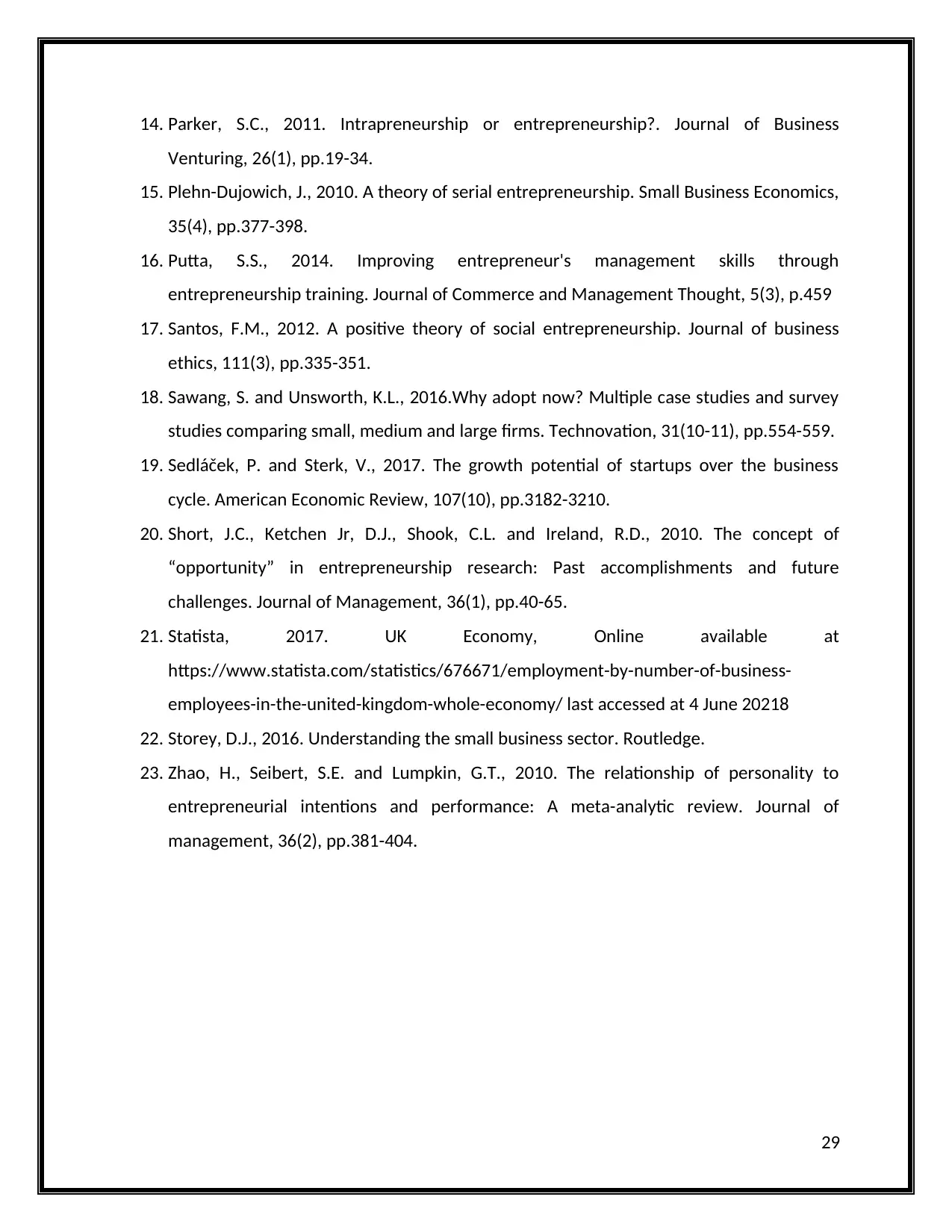
14. Parker, S.C., 2011. Intrapreneurship or entrepreneurship?. Journal of Business
Venturing, 26(1), pp.19-34.
15. Plehn-Dujowich, J., 2010. A theory of serial entrepreneurship. Small Business Economics,
35(4), pp.377-398.
16. Putta, S.S., 2014. Improving entrepreneur's management skills through
entrepreneurship training. Journal of Commerce and Management Thought, 5(3), p.459
17. Santos, F.M., 2012. A positive theory of social entrepreneurship. Journal of business
ethics, 111(3), pp.335-351.
18. Sawang, S. and Unsworth, K.L., 2016.Why adopt now? Multiple case studies and survey
studies comparing small, medium and large firms. Technovation, 31(10-11), pp.554-559.
19. Sedláček, P. and Sterk, V., 2017. The growth potential of startups over the business
cycle. American Economic Review, 107(10), pp.3182-3210.
20. Short, J.C., Ketchen Jr, D.J., Shook, C.L. and Ireland, R.D., 2010. The concept of
“opportunity” in entrepreneurship research: Past accomplishments and future
challenges. Journal of Management, 36(1), pp.40-65.
21. Statista, 2017. UK Economy, Online available at
https://www.statista.com/statistics/676671/employment-by-number-of-business-
employees-in-the-united-kingdom-whole-economy/ last accessed at 4 June 20218
22. Storey, D.J., 2016. Understanding the small business sector. Routledge.
23. Zhao, H., Seibert, S.E. and Lumpkin, G.T., 2010. The relationship of personality to
entrepreneurial intentions and performance: A meta-analytic review. Journal of
management, 36(2), pp.381-404.
29
Venturing, 26(1), pp.19-34.
15. Plehn-Dujowich, J., 2010. A theory of serial entrepreneurship. Small Business Economics,
35(4), pp.377-398.
16. Putta, S.S., 2014. Improving entrepreneur's management skills through
entrepreneurship training. Journal of Commerce and Management Thought, 5(3), p.459
17. Santos, F.M., 2012. A positive theory of social entrepreneurship. Journal of business
ethics, 111(3), pp.335-351.
18. Sawang, S. and Unsworth, K.L., 2016.Why adopt now? Multiple case studies and survey
studies comparing small, medium and large firms. Technovation, 31(10-11), pp.554-559.
19. Sedláček, P. and Sterk, V., 2017. The growth potential of startups over the business
cycle. American Economic Review, 107(10), pp.3182-3210.
20. Short, J.C., Ketchen Jr, D.J., Shook, C.L. and Ireland, R.D., 2010. The concept of
“opportunity” in entrepreneurship research: Past accomplishments and future
challenges. Journal of Management, 36(1), pp.40-65.
21. Statista, 2017. UK Economy, Online available at
https://www.statista.com/statistics/676671/employment-by-number-of-business-
employees-in-the-united-kingdom-whole-economy/ last accessed at 4 June 20218
22. Storey, D.J., 2016. Understanding the small business sector. Routledge.
23. Zhao, H., Seibert, S.E. and Lumpkin, G.T., 2010. The relationship of personality to
entrepreneurial intentions and performance: A meta-analytic review. Journal of
management, 36(2), pp.381-404.
29

30
1 out of 31
Related Documents
Your All-in-One AI-Powered Toolkit for Academic Success.
+13062052269
info@desklib.com
Available 24*7 on WhatsApp / Email
![[object Object]](/_next/static/media/star-bottom.7253800d.svg)
Unlock your academic potential
© 2024 | Zucol Services PVT LTD | All rights reserved.





